
What Is A Catamaran Sailboat? (And What It Looks Like)

Catamarans are increasingly popular for sailing and commercial use, but what sets them apart from monohulls and other multihulls?
A catamaran is a twin-hull boat with two equally-sized hulls placed side by side. They’re powered by engines, sails, or both—and they’re known for efficiency and speed. Catamarans are the most common kind of multihull boat.
In this article, we’ll go over the characteristics of catamarans and how to differentiate them from other types of boats. Additionally, we’ll cover the advantages and disadvantages of catamarans and compare them to trimarans and monohulls. We’ll also go over the most common types of catamarans and their uses.
We sourced the information in this article from marine design guides, boat identification resources, and the online boating community.
Table of contents

How to Spot a Catamaran
Spotting a catamaran is easy. Simply look at the hulls and count them. Catamarans have two hulls side by side and a relatively large gap between them where you can see light on the other end. Catamarans are distinct from trimarans, which have an additional hull between the two outer hulls.
How do Catamarans Work?
The principle behind the catamaran is simple. You can think of catamarans like cars and monohulls like motorcycles. Catamarans distribute their weight between hulls on either side, whereas monohulls utilize only one hull.
Evidently, cars are much more difficult to tip over and can hold much more weight. Additionally, cars are wider, as they have much more contact with the road. Catamarans work in a similar way, as they have a wide stance and contact with the surface on both sides.
Obviously, that isn’t the most precise comparison. But the basic principle is the same, and catamarans have a few notable benefits over monohulls.
Catamaran Vs Monohull
Catamarans are easy to distinguish from monohulls. A monohull is just a regular old boat with a single hull. The vast majority of boats and ships are monohulls. Catamarans have two hulls, which are usually sleek and narrow.
Here are some comparisons of catamarans and monohulls, along with the advantages twin-hull designs have over most single hull types.
Benefits of Catamarans
Catamarans have numerous benefits. The first is speed. Catamarans produce less drag than monohulls and thus can achieve excessive speeds both under sail and power. They don’t need to plane like monohulls to achieve these high speeds, and they use less fuel.
Catamarans are also much more stable than monohulls. They have a wide stance and shallow draft, and many waves and swells can travel between the hulls instead of below them. This effectively reduces an entire axis of movement and prevents catamarans from rolling excessively.
Drawbacks of Catamarans
Catamarans aren’t advantageous in every way, or else we wouldn’t bother building monohulls. The disadvantages of catamarans limit their use to niche commercial applications and high-end yachts. But what are the drawbacks of a twin-hull design?
Sailing catamarans don’t follow many of the traditional boat handling rules and characteristics that sailors pass down for generations. Some, such as hull speed limitations, are good to do away with—while others, such as responsiveness, are not.
Catamarans aren’t as quick to the helm or responsive as monohulls. There are some exceptions to this rule, but for the most part, you’ll get a lot more feedback from a single-hull vessel. Additionally, the large section of deck between the hulls of a catamaran is prone to pounding in rough seas, which is loud and uncomfortable.
Catamarans can sometimes be twice the width of an equivalent monohull sailboat, which can increase mooring fees and limit docking options.
The final major drawback of catamarans is a consequence of their stability. Traditional full-keel monohull sailboats have a very low center of gravity, which makes them roll in heavy seas but ensures a recovery.
Catamarans have a higher center of gravity, and they can’t right themselves after a knockdown. And though catamarans are less likely to roll, a severe list on a multihull is a much more serious concern than on a ballasted monohull.
Catamaran Vs Trimaran
Catamarans and trimarans are often lumped together, but they have very different design and performance specifications. Trimarans have three hulls, whereas catamarans have two.
Trimarans look a lot like catamarans from the side, but a quick glance at the bow or stern can set them apart. Trimarans are faster than catamarans, as they distribute their weight across three hulls instead of two. This helps them stay centered and reduces interference from pitching and rolling.
Catamarans are fast, but they lose out to trimarans when going head to head. However, catamarans are much less expensive to build and maintain and often have roomier cabins due to their larger hulls.
Types of Catamarans
There are numerous types of catamarans, and their uses vary widely. The catamaran is one of the oldest and most useful hull types, and some variants have been used for thousands of years. Here are the most common kinds of catamaran boats and their uses.
Sailing Catamaran
Sailing catamarans are probably what you think of when you hear the name. Sailing catamarans are sailboats with two identical hulls connected by a center deck. The largest sailing catamarans are spacious and stable vessels that are capable of serious offshore sailing.
Sailing catamarans have a number of notable advantages over monohulls. Monohulls, which are traditional sailboats with a single hull, are limited by a simple concept called hull speed. As the bow and stern wave of a monohull intersect, they cause drag which limits the top speed of the boat.
Catamarans are not bound by hull speed limitations, as they have two hulls. Catamarans can go twice or even three times as fast as similar monohulls and achieve excellent travel times.
Catamarans are also more stable than monohulls, as their wide stance and shallow draft reduce the effect of rough water. They don’t heel, as the force of the wind is counteracted by the double hulls. Additionally, modern sailing catamarans can ‘wave pierce’ by cutting through swells instead of riding over them.
Sailing catamarans come in many shapes and sizes. Small sailing catamarans, such as those used in races and regattas, are known for their speed and relative stability compared to light racing monohulls. Sometimes, they feature a smaller second hull for stability—these are called outriggers.
Sailing catamarans have spacious interiors thanks to the large cockpit between the hulls. This cockpit usually contains cooking and eating spaces, a place to sit, and a hallway between the hulls. The hulls usually contain living quarters and often mirror each other.
Power Catamarans
Power catamarans have an even greater variety than sailing catamarans. These vessels are used for everything from party platforms to ferries and patrol boats.
Power catamarans are a recent development, as engineers and marine architects now realize they have numerous hydrodynamic advantages over other hull types.
Catamarans are much more efficient than other hull types, as they have less drag relative to their size. Additionally, you can build a much larger catamaran with less material. This makes them popular for car and rail ferries, as builders can construct a very wide vessel with two small hulls rather than a narrower vessel with a large single hull.
Military and Commercial Catamarans
Even the military has found a use for the catamaran hull shape. The Spearhead class EPF is an expeditionary fast transport vessel designed for carrying capacity and speed. It has two sharp hulls and a huge cargo capacity.
The Spearhead class EPF is 337 feet long, which is about the same length as a WW2 escort destroyer. Yet despite having a similar length and displacement, these catamarans can travel more than twice as fast—43 knots, or nearly 50 miles per hour. Their great speed is a direct consequence of their catamaran hull type.
Power catamarans are also used as patrol and utility boats on a much smaller scale, with either outboard or inboard motors. The State of Texas uses catamarans to patrol shallow rivers and lakes. Texas Game Wardens utilize state-of-the-art aluminum catamaran patrol boats, which are fast enough to outrun most fishing boats.
There’s another form of power catamaran that you may not have considered. Pontoon boats are technically catamarans, and they’re enormously popular on lakes and rivers throughout the country. Pontoon boats aren’t known for speed, but they’re a great platform for a fun and comfortable outing.
Catamaran Houseboats
The final common type of power catamaran is the two-hulled houseboat. Houseboats don’t always use the catamaran hull type, but it’s common enough that most major manufacturers offer it as an option.
Catamaran houseboats have a few notable advantages over monohull designs. For one, they’re easier to build—especially when pontoons are chosen. Additionally, they’re better suited for navigating shallow water. These vessels can support more weight across their two hulls, offer increased stability, and they’re also efficient.
Why Aren’t Catamarans More Common?
With all the advantages listed in this article to consider, it may seem strange that the use of catamarans is still somewhat limited. At the end of the day, it comes down to economics—as monohull boats and ships are simply cheaper to build.
Additionally, catamarans have some distinct limitations. Monohulls have lots of storage space in their hulls and can carry thousands of tons of cargo safely in all weather conditions. Catamarans lack this space and low center of gravity, so they’re not ideal for transporting cargo past a certain point.
Additionally, monohulls work, and many people are reluctant to experiment with new designs when old designs work just fine. This rule applies to both large and small boats.
A large monohull sailboat can be constructed at low cost from stock plans and reliably sail almost anywhere. Very little complex structural engineering is involved, and looser tolerances reduce cost and maintenance requirements.
Related Articles
Daniel Wade
I've personally had thousands of questions about sailing and sailboats over the years. As I learn and experience sailing, and the community, I share the answers that work and make sense to me, here on Life of Sailing.
by this author
Learn About Sailboats
Most Recent

What Does "Sailing By The Lee" Mean?
October 3, 2023

The Best Sailing Schools And Programs: Reviews & Ratings
September 26, 2023
Important Legal Info
Lifeofsailing.com is a participant in the Amazon Services LLC Associates Program, an affiliate advertising program designed to provide a means for sites to earn advertising fees by advertising and linking to Amazon. This site also participates in other affiliate programs and is compensated for referring traffic and business to these companies.
Similar Posts

Affordable Sailboats You Can Build at Home
September 13, 2023

Best Small Sailboat Ornaments
September 12, 2023

Discover the Magic of Hydrofoil Sailboats
December 11, 2023
Popular Posts

Best Liveaboard Catamaran Sailboats
December 28, 2023

Can a Novice Sail Around the World?
Elizabeth O'Malley
June 15, 2022

4 Best Electric Outboard Motors

How Long Did It Take The Vikings To Sail To England?

10 Best Sailboat Brands (And Why)
December 20, 2023

7 Best Places To Liveaboard A Sailboat
Get the best sailing content.
Top Rated Posts
© 2024 Life of Sailing Email: [email protected] Address: 11816 Inwood Rd #3024 Dallas, TX 75244 Disclaimer Privacy Policy
- Destination Information
- Sailing routes
- Boat owners
- Tips & Inspiration
- Sustainable Sailing

- Nautical Knowledge
What is a Catamaran? The World of Twin-Hulled Boats
- 14 April 2023
- 5 minute read
Alice Martin

Share the post "What is a Catamaran? The World of Twin-Hulled Boats"
Welcome aboard our nautical adventure as we look into what a catamaran is. If you’ve ever been interested by these twin-hulled vessels and wondered what sets them apart from other boats, you’re in the right place! In this post, we’ll explore their unique features and why they’re becoming an increasingly popular choice among sailors. We’ll also touch on the environmental benefits of chartering one, the science behind their stability. Lastly, we’ll provide you with a calendar of must-attend regattas and festivals. With summer approaching and boats ready to book with Click&Boat , let’s set sail and explore the world of twin-hulled boats!
What is a catamaran?
It is a type of multi-hulled boat, with two parallel hulls of equal size, also known as pontoon boats. This unique double-hulled design originated from traditional fishing boats and sailing vessels in the South Pacific and offers a range of benefits for sailors. They are available in various sizes and can be powered by sails or engines, making them extremely versatile.
Different types of catamarans
Catamarans come in different shapes and sizes, each offering unique features and benefits. Cruising catamarans are designed for leisurely sailing, with spacious cabins and amenities. Racing catamarans, are built for speed and performance, with lightweight construction and streamlined design. Power catamarans are perfect for those who want the speed of a motorboat with the stability of a catamaran. Finally, ferry catamarans are larger vessels designed for commercial use, with the ability to carry passengers and vehicles.

Catamaran vs. Monohull: The Great Sailing Debate
The debate between catamarans and monohulls is popular in the sailing community, with both types of vessels offering unique advantages and disadvantages. Let’s explore some of the key differences between these sailing boats.
- Speed: Generally, they have a speed advantage over Monohulls. This is thanks to their reduced water resistance and lighter construction. The top speeds can be up to 60 knots. This power of catamarans is particularly appealing for those interested in racing or covering long distances quickly.
- Space and comfort: Typically they provide more living space and bridge deck than Monohulls. This makes them an attractive choice for families, groups, or long-term cruisers who value comfort and room for onboard activities. Monohulls, while more compact, can still be cosy and offer a more intimate sailing experience.
- Draft and access: They have a shallower draft than Monohulls, allowing them to navigate and anchor in more shallow waters. This can open up a wider range of cruising destinations and reduce the risk of damaging sensitive marine habitats. Monohulls, on the other hand, are limited to deeper waters and marinas.
- Manoeuvrability: Many sailing enthusiasts consider Monohulls easier to steer than catamarans, particularly in tight spaces or crowded marinas. Catamarans, while still agile, require more skill and practice to steer confidently.
- Maintenance and costs: Catamarans are more expensive to purchase and maintain due to their larger size and the need for two engines or sets of sails. Monohulls, while potentially cheaper, can still be expensive depending on their age, condition, and equipment.
- Sailing characteristics : Monohulls offer a more traditional sailing experience, with the boat heeling and responding more dramatically to wind and waves. This can be exhilarating for some sailors, while others may prefer the more level, stable ride of a catamaran.
The Science of Catamaran Stability
The stability is a result of its unique design, which offers several advantages over traditional monohulled boats. Let’s explore some of these!
- Wide beam: This is the distance between its two hulls, provides a stable platform that resists rolling and heeling (tipping) when underway. This means that catamarans are less likely to capsize and provide a smoother ride for passengers in rough conditions.
- Distribution of weight: The twin-hull design allows for a more even distribution of weight across the vessel. This reduces the boat’s center of gravity and makes it more resistant to capsizing, especially in comparison to monohulled boats with a narrower hull and a higher center of gravity.
- Buoyancy and displacement: Each hull has its own buoyancy and displacement, which contributes to the vessel’s overall stability. This means that even if one hull were to become compromised, the other hull would still provide sufficient buoyancy to keep the boat afloat.
- Damping effect: The wide beam of a catamaran also provides a damping effect on the motion of the boat. This means that when the boat encounters waves or wakes, the movement is less abrupt and more gradual, resulting in a smoother and more comfortable ride for passengers.
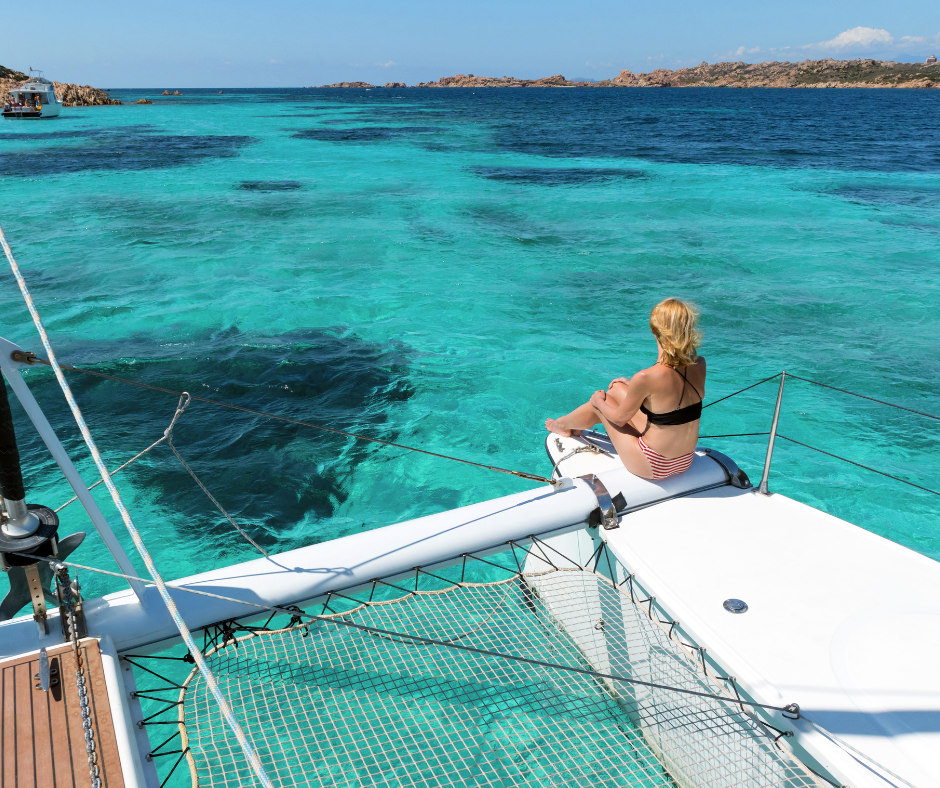
The environmental benefits of sailing a catamaran
Calling all eco-conscious sailors! Did you know that catamarans are not only fast and comfortable but also offer numerous environmental advantages? Here’s why these boats are becoming more popular amongst sailing enthusiasts.
The boat design translates to less water resistance and energy consumption, making them a greener choice for those mindful of their carbon footprint. Their shallow draft allows you to navigate shallow waters without harming marine habitats like coral reefs and seagrass beds, with minimal environmental impact. Modern boats often accommodate solar panels and wind generators, allowing you to harness clean, renewable energy for guilt-free sailing. Some manufacturers are also turning to sustainable, recyclable materials to lessen the environmental impact of boat production. Click&Boat offers various eco friendly options for those who prefer more sustainable sailing.
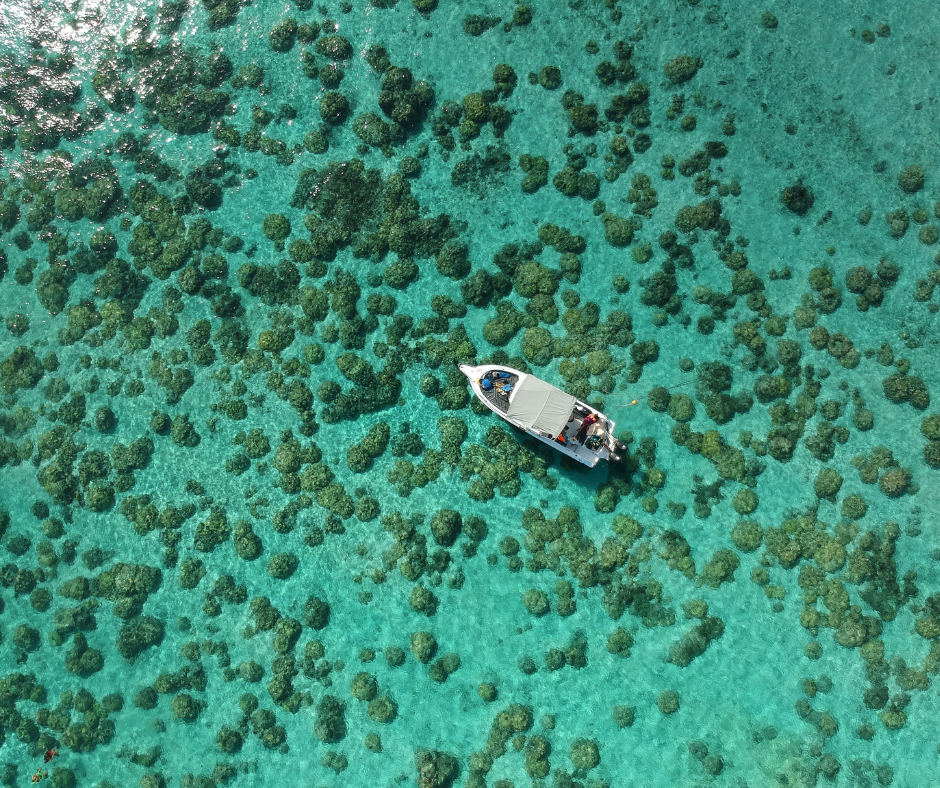
Catamaran Regattas and Festivals: A Calendar of Must-Attend Events 2023
It’s time to finish with a list of the must- attend events of 2023! Here are our top recommendations.
Les Voiles de St Barths Richard Mille 16-22 April
With 1,200 sailing enthusiasts and 63 boats, this race takes place over 5 days on difficult coastal routes in the town of Gustavia .
Giorgio Armani Superyacht Regatta 6-10 June
If you are looking for a more glamorous event, this is the one for you. This prestigious event takes place over 4 days off the coast of Sardinia.
Round Texel Race 10 June
This Dutch event is the world’s largest catamaran race, with hundreds of competitors sailing around the island of Texel in the North Sea.
Cannes Yachting Festival 12-17 September
This event is a must-attend for both yachting enthusiasts in Cannes . This show will be one of the top yacht exhibitions in Europe, drawing in around 700 boats annually including luxury catamarans.
So now that you’re up to speed on everything catamaran, it’s time to set sail into the sunset!
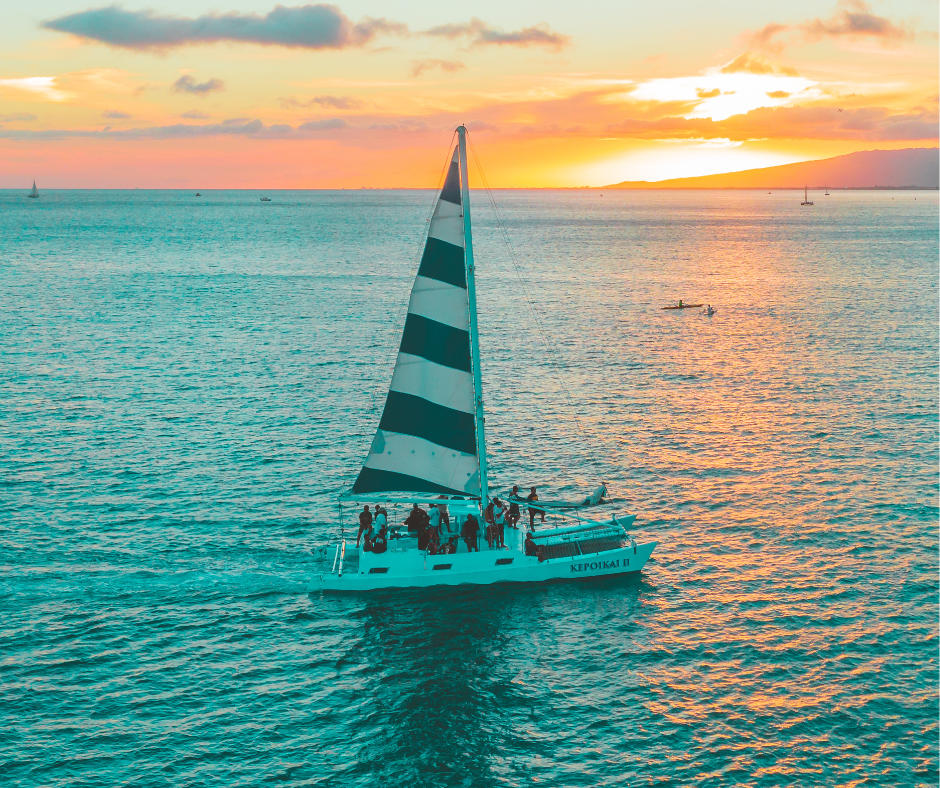
- Inspiration
The Best Sailing Movies of all Time – Top 12 to Watch
- 6 April 2023
- Kate Fitzgerald

The History of Sailing and its Role in Society
- 21 April 2023
- Clara Chambers
You May Also Like
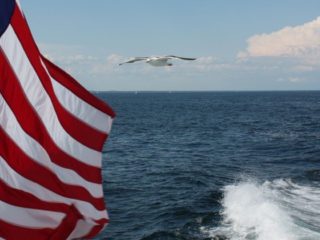
What you need to know for a boat safety certificate in the United States
- 7 July 2024
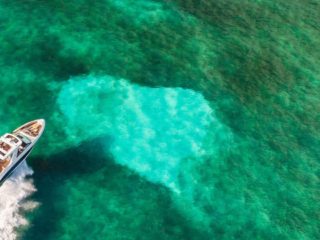
Budgeting for your daily boat hire
- 6 July 2024
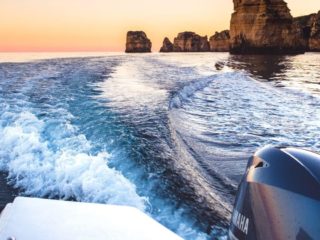
- Featured Posts: The Latest News
For your next motorboat trip: A skippered or a bareboat charter?
- 3 July 2024

What to bring aboard a motorboat: your boating checklist
- 1 July 2024

First time renting with Click&Boat? Here’s What You Need to Know!
- 30 June 2024

- About Click&Boat
Click&Boat’s guide to using a boat licence abroad
- 29 June 2024
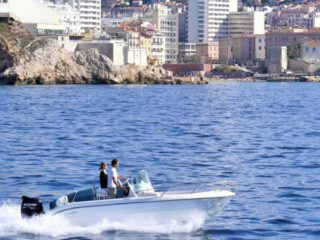
All you need to know about a daily boat hire
- 28 June 2024
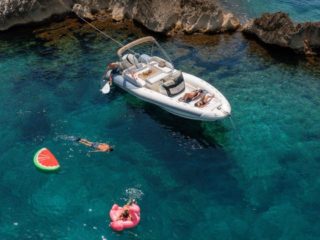
Click&Boat’s suggestions for a daily motorboat rental
- 27 June 2024
Leave a Reply Cancel reply
Your email address will not be published. Required fields are marked *
Save my name, email, and website in this browser for the next time I comment.
This site uses Akismet to reduce spam. Learn how your comment data is processed .
Input your search keywords and press Enter.
| Tip: Use ? for unknown answer letters, ex: UNKNO?N | |
- Crossword Tips
Clue: Twin-hulled sailboat
Referring crossword puzzle answers, likely related crossword puzzle clues.
- Regatta racer
- Type of boat
- America's Cup entrant
- Twin-hulled boat
- Twin-hulled vessel
- Where a pole may be found
- America's Cup participant
- Boat for felines?
- Multi-hulled craft
- Boat with two hulls
Recent usage in crossword puzzles:
- Sheffer - Oct. 27, 2014
- Universal Crossword - Aug. 4, 2008
- Universal Crossword - Jan. 23, 2002
- Quick Solve
- Solution Wizard
- Clue Database
- Crossword Forum
- Anagram Solver
- Online Crosswords
Twin-hulled boat - Crossword Clue
Below are possible answers for the crossword clue Twin-hulled boat .
9 letter answer(s) to twin-hulled boat
- a sailboat with two parallel hulls held together by single deck
Other crossword clues with similar answers to 'Twin-hulled boat'
Still struggling to solve the crossword clue 'twin-hulled boat'.
If you're still haven't solved the crossword clue Twin-hulled boat then why not search our database by the letters you have already!
- Words By Letter:
- Clues By Letter:
- » Home
- » Quick Solve
- » Solution Wizard
- » Clue Database
- » Crossword Help Forum
- » Anagram Solver
- » Dictionary
- » Crossword Guides
- » Crossword Puzzles
- » Contact
© 2024 Crossword Clue Solver. All Rights Reserved. Crossword Clue Solver is operated and owned by Ash Young at Evoluted Web Design . Optimisation by SEO Sheffield .
Privacy Policy | Cookie Policy
- 2024 BOAT BUYERS GUIDE
- SHALLOW WATER FISHING
- Email Newsletters
- Boating Tips
- Boating Safety
- Electronics
- Baits & Lures
- Fishing Tackle
- Fishing Travel
- Conservation
- Fishing Knots
- Women in Fishing

Next Generation High Performance Bay Boats
- By Jim Hendricks
- August 7, 2023
’Twas a time not so long ago when a bay boat with twin outboards stood out as an oddity, a Frankenstein experiment of sorts, viewed as overkill, unnecessary or just showing off. Yet, fast forward to today, and that’s no longer the case. As models have grown larger and now boast hybrid hulls and interiors with offshore, as well as inshore, capabilities, the era of the twin-outboard-power bay boat is upon us. Here are 10 examples of such twin-outboard center-console machines (listed in order of length overall from smallest to largest).
YELLOWFIN 26 HYBRID
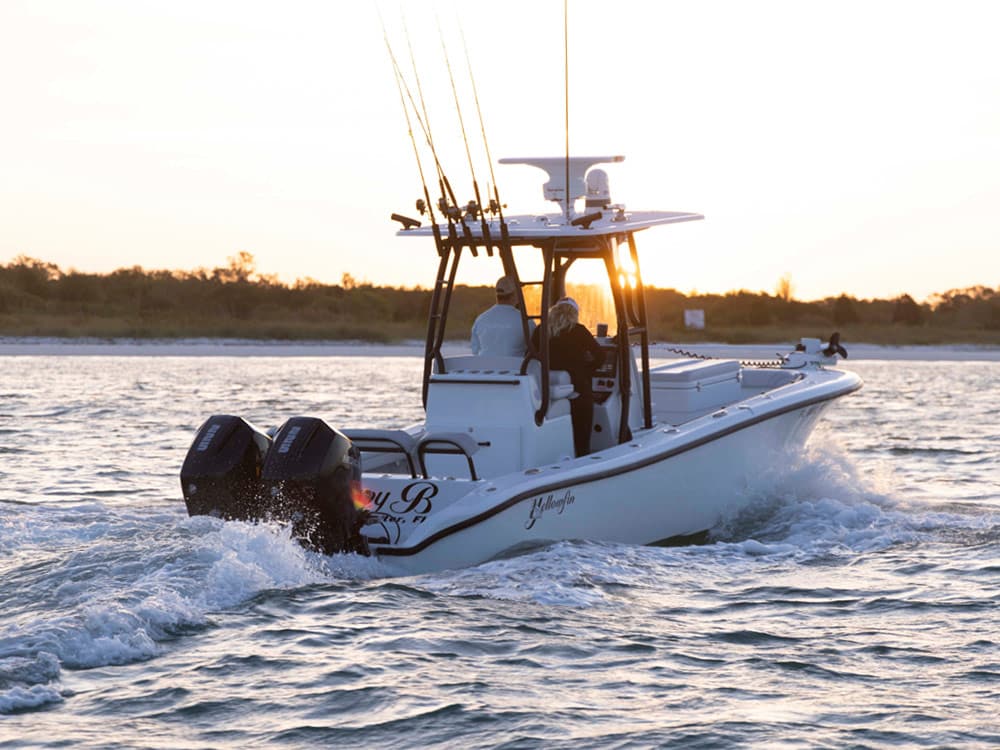
The Y ellowfin 26 Hybrid represents one of the smallest bay boats available with twin outboards. This highly customizable, offshore capable model can handle a pair of outboards up to 500 hp total. For inshore fishing, it drafts just 1 feet, 4 inches, striking a practical compromise between the shallows and bluewater. The 26 Hybrid carries 118 gallons of fuel, and there are hardtop and tower options to customize this model for the way you fish. You can also order the forward seating option or choose an insulated coffin box for the forward deck. An upright livewell resides in the leaning post module abaft the helm seating.
- Draft: 1’4” (engines up)
- Transom Deadrise: 21 degrees
- Weight: 5,000 lb.
- Fuel Capacity: 118 gal.
- Max Horsepower: 500
SHEARWATER 270 CAROLINA OPEN
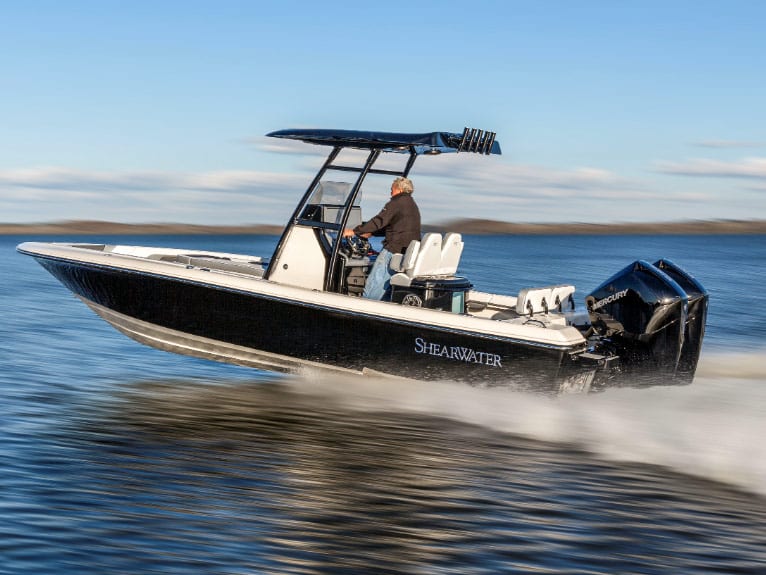
The 270 Carolina Open from ShearWater represents one of the first bay boats to confer this genre with available twin outboards, making it a bit of a curiosity about a decade ago, but now it is one among the mainstream in twin-outboard bay boat category. At 26 feet, 10 inches in length, it carries a maximum horsepower rating a 600. The HPI (High Pressure Injection) system results in a high-strength, lightweight hull, which sports an 8-foot, 8-inch beam. The 270 Carolina Open drafts 1 foot, 4 inches with the engines up and provides a fuel capacity of 129 gallons. It is available with twin Mercury or Yamaha outboards, including Merc 225 V-6s and Yamaha F300 V-6s.
- LOA: 26’10”
- Transom Deadrise: NA
- Weight: 4,800 lb. (without power)
- Fuel Capacity: 129 gal.
- Max Horsepower: 600
SEAVEE 270Z
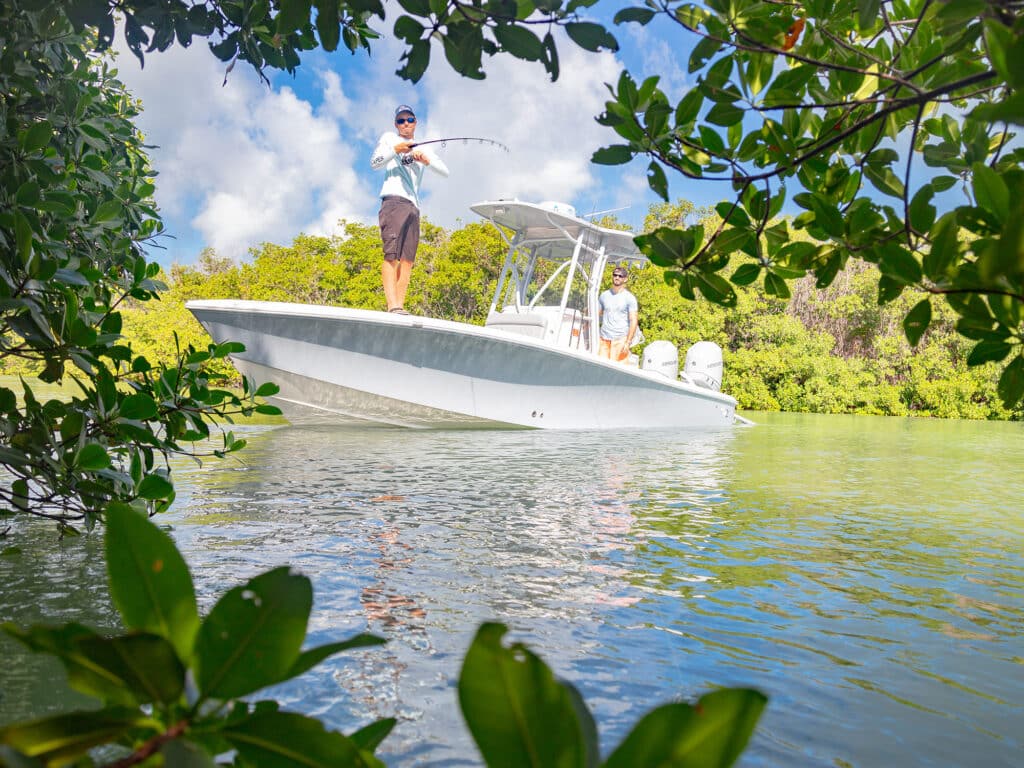
SeaVee Boats 270Z Bay is available with twin outboards up to 600 hp total. The 27-footer boasts a 9-foot-1-inch beam and reflects a traditional bay-boat interior, with forward and aft casting platforms that sit high and spacious, 1-inch-high toe kicks all around, and a recessed cockpit amidships. The vacuum-resin-infusion process used to build the hull and deck translates into lighter weight and a shallower draft. With 17 degrees of transom deadrise, the double-stepped hull drafts just 1 foot, 3 inches of water at rest. Multiple lifting bodies of the double-stepped Z-hull optimize the trim angle to help smooth the ride. A 116-gallon fuel tank provides ability to fish far and wide. Inside, twin insulated 6-foot-long 75-gallon fish boxes and a stowage space for a 5-gallon bucket and eight life jackets are built into the forward casting platform and drain overboard. A 25-gallon livewell is integrated into the forward cockpit, and a 30-gallon pressurized livewell resides under the aft deck. There’s also a foldout bench seat concealed under the aft deck. The center console has room for flush-mounting a MFD as large as 16 inches. It also features forward seating and a 68-quart cooler underneath. An optional hardtop is available, and it’s engineered to accommodate a second station aloft.
- Draft: 1’3” (engines up)
- Transom Deadrise: 17 degrees
- Weight: 3,500 lb. (without power)
- Fuel Capacity: 116 gal.
EVERGLADES 273CC
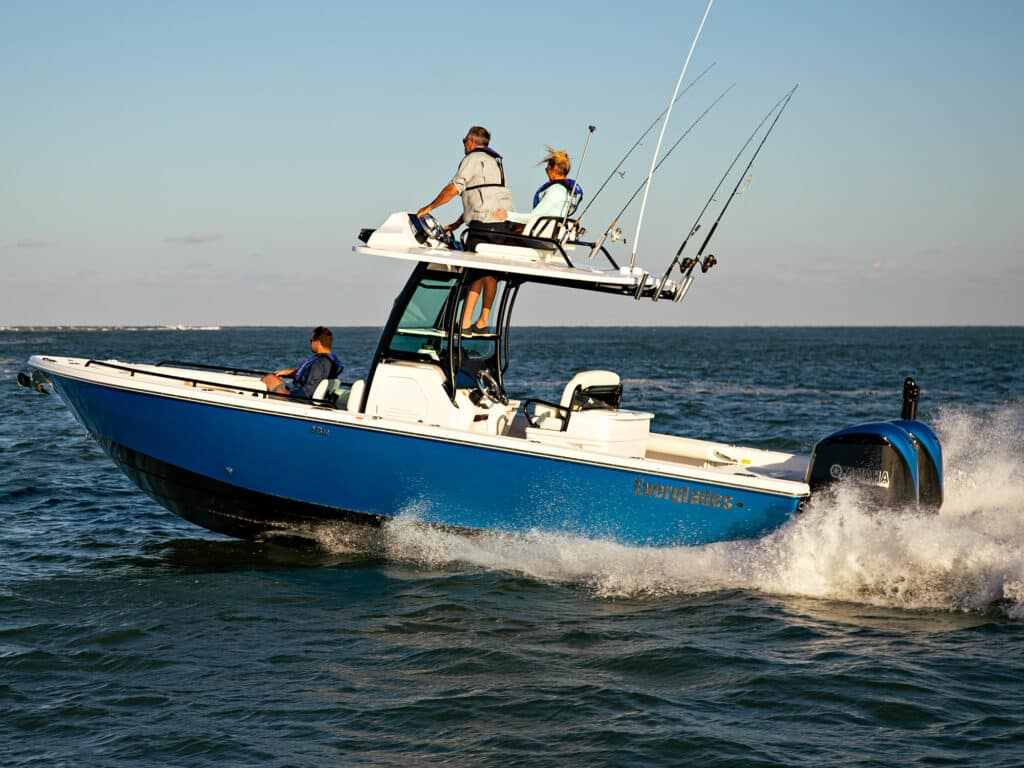
The Everglades 273CC sports twin Yamaha F300 DES outboards, and there’s an option to add the Yamaha Helm Master EX system. Drafting just 1½ feet, the 273CC boasts a wave-slicing variable-deadrise V-hull with 20 degrees transom deadrise, generous freeboard and Everglades RAMCAP construction. A spacious forward casting platform is made possible by a filler placed between the bow seating/lounge modules. Remove the filler for unobstructed access to the bow. The aft platform is abbreviated, but has a pair of jump seats. A 31-gallon livewell resides in the leaning post abaft the deluxe helm seats, along with tackle-storage and bait-prep center, and a sink with a pullout freshwater washdown hose. An insulated 82-gallon fish box resides below the forward deck. The standard hardtop features an aluminum powder-coating frame, LED lighting, an electronics box, four rod holders, and a ski pylon for days when watersports supplant fishing. Everglades equips the 273CC with a tempered-glass windshield that slides downward at the push of button to usher in a breeze on sultry days. A variety of optional marine electronics packages is available from Garmin.
- Draft: 1’6” (engines up)
- Transom Deadrise: 20 degrees
- Weight: 7,500 lb. (with power)
- Fuel Capacity: 157 gal.
GRADY-WHITE 281 CE
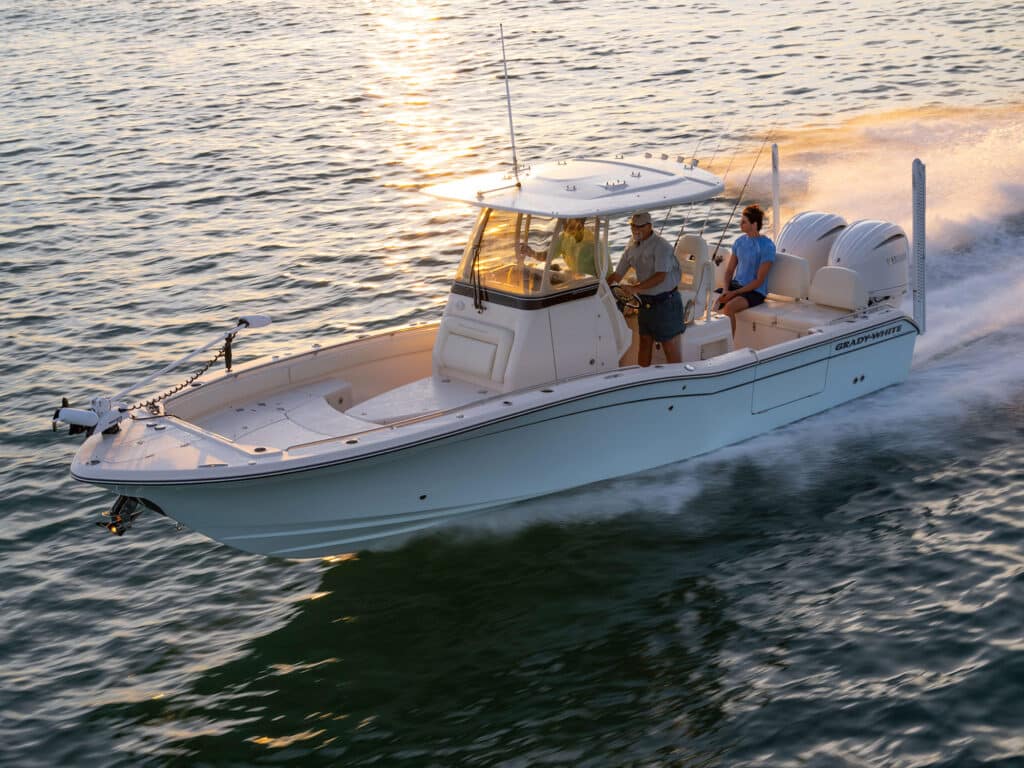
The Grady-White 281 CE is available with twin Yamaha F300 DES outboards. The Yamaha Helm Master EX with the optional Full Maneuverability package is a great option with the twin-outboard setup. The Grady SeaV2 hull on this boat features 16 degrees of transom deadrise that artfully sharpens at cutwater. The sheer sweeps gracefully upward and incorporates a classic Carolina flare for a smooth, dry ride. For fishing inshore, the 281 CE drafts 1 foot, 7 inches. The layout includes a wide-open forward casting platform formed by using the forward snack tabletop and a crescent-shaped insert as fillers. Remove both to create unfettered access to the bow between the forward loungers. The aft platform doubles as a comfy bench seat, but remove the middle backrest and swing the two outer backrests 90 degrees to serve as elevated coamings while standing. The 281 sports a 38-gallon livewell in the leaning post and an integral hardtop with a wraparound, full-height windshield. The 281 CE is also the only bay boat to feature a fully electric-powered side door. This standard feature is called the Sport Deck, and it pivots downward to serve as a cool swim platform or haul a big offshore fish aboard.
- Draft: 1’7” (engines up)
- Transom Deadrise: 16 degrees
- Weight: 5,650 lb. (without power)
- Fuel Capacity: 160 gal.
BOSTON WHALER 280 DAUNTLESS
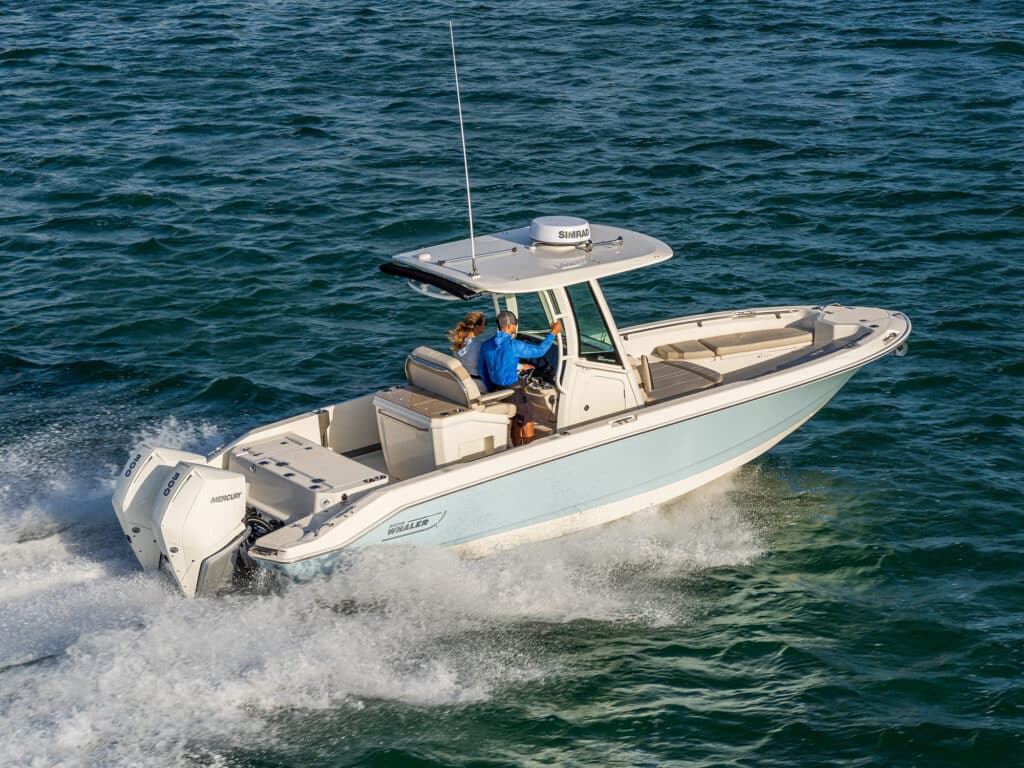
The 280 Dauntless is available with twin Mercury 250 or 300 outboards. With a 27-foot-9-inch length overall, 9-foot beam and a transom deadrise of 18 degrees, the 280 can float in 1½ feet of water with the outboards trimmed up. A big bow casting platform converts to bow seats and lounges. There’s a 19-gallon livewell and a large forward fish box with a pump-out. A swim patio deploys from the port side of the aft cockpit for convenient access to the water. An optional gyrostabilizer (a rare feature on a bay boat) minimizes roll. A full-height three-sided glass windshield (with a vent atop the center panel) protects the helm, and the console dash includes Simrad navigation electronics, a JL Audio system and digital switching. The doublewide helm seat has flip-down armrests and flip-up bolsters so you can sit or stand while driving. The helm seat also can electrically convert to a simple leaning post for the captain at the helm while creating two aft-facing seats for crew.
- Transom Deadrise: 18 degrees
- Weight: 5,495 lb. (without power)
CAYMAS 281 HB
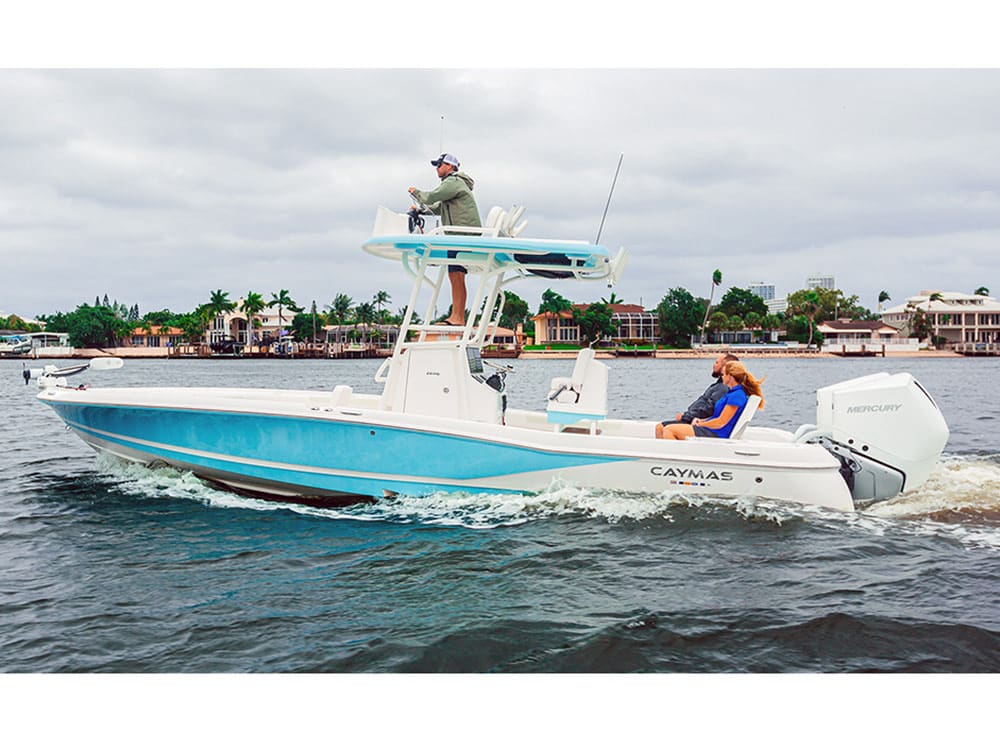
The Caymas 281 HB hybrid bay boat is available with twin Mercury, Suzuki and Yamaha outboards up to 600 hp total. A 200-gallon fuel capacity results in superb cruising range. A Michael Peters double SVVT (Stepped-Vee Ventilated Tunnel) hull delivers speed, a smooth ride, and fuel efficiency. With 18.5 degrees of transom deadrise, the 281 HB drafts 1 foot, 4 inches at rest with the outboard(s) tilted up. Roomy bay-boat-style casting decks lie fore and aft, with a cockpit in between providing 26 inches of gunwale height. Amenities include a pair of 35-gallon livewells, foldout seating under the stern deck, a 45-gallon forward fish box, and roomy stowage lockers for tackle and gear. A tempered-glass windshield with a powder-coated aluminum frame protects the helm that includes a fiberglass leaning post with flip-up bolster seats and a backrest, four rod holders, a pair of stainless-steel drink holders, and a rigging station on the backside. The dash will accommodate a pair of 12-inch multifunction displays. Hardtop options with and without second stations aloft boast powder-coated aluminum pipework.
- LOA: 27’11”
- Transom Deadrise: 18.5 degrees
- Weight: 4,300 lb. (without power)
- Fuel Capacity: 200 gal.
SCOUT 281 XSS
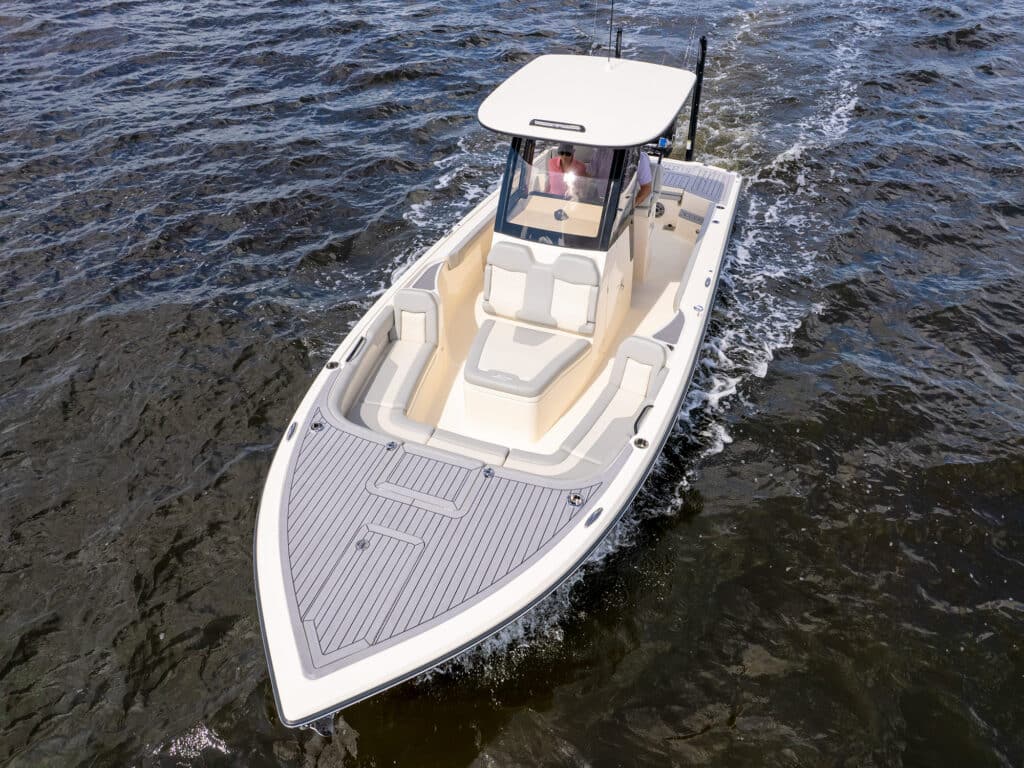
Scout’s 281 XSS is available with twin Mercury 225 DTS V-6s or 300 Pro XS V-8s. Advanced epoxy-infused carbon-fiber and E-glass construction minimizes weight, ensures durability and maximizes performance. With 15.5 degrees of transom deadrise, 281 XSS drafts just 1 foot, 2 inches. Yet the double-stepped hull has a sharp entry to slice through choppy seas. Big casting platforms fore and aft give anglers plenty of elevation. A fuel capacity of 126 gallons offers great fishing range. An 18-gallon livewell integrates into the leaning post, as is a slide-out 65-quart cooler, four rod holders, and lockers for fishing tackle. Under the aft casting deck is a pair of voluminous fish boxes that can be optionally plumbed as livewells. There’s also dedicated fender stowage and a foldout bench seat. A pair of helm chairs cradle the captain and co-pilot, and the helm features a pair of Garmin 10-inch multifunction displays. There’s an additional switch panel in the intricately crafted hardtop, which also includes four Fusion stereo speakers. A three-sided glass windshield shelters the helm area. An inviting forward console lounge features backrests and fold-down armrests. In the bow you’ll find wraparound seating with backrests to create a pair of forward-facing lounges. Classic Scout styling and optional colors add to the pride of ownership.
- Draft: 1’2” (engines up)
- Transom Deadrise: 15.5 degrees
- Weight: 5,457 lb. (without power)
- Fuel Capacity: 126 gal.
SOLACE 30 HCS
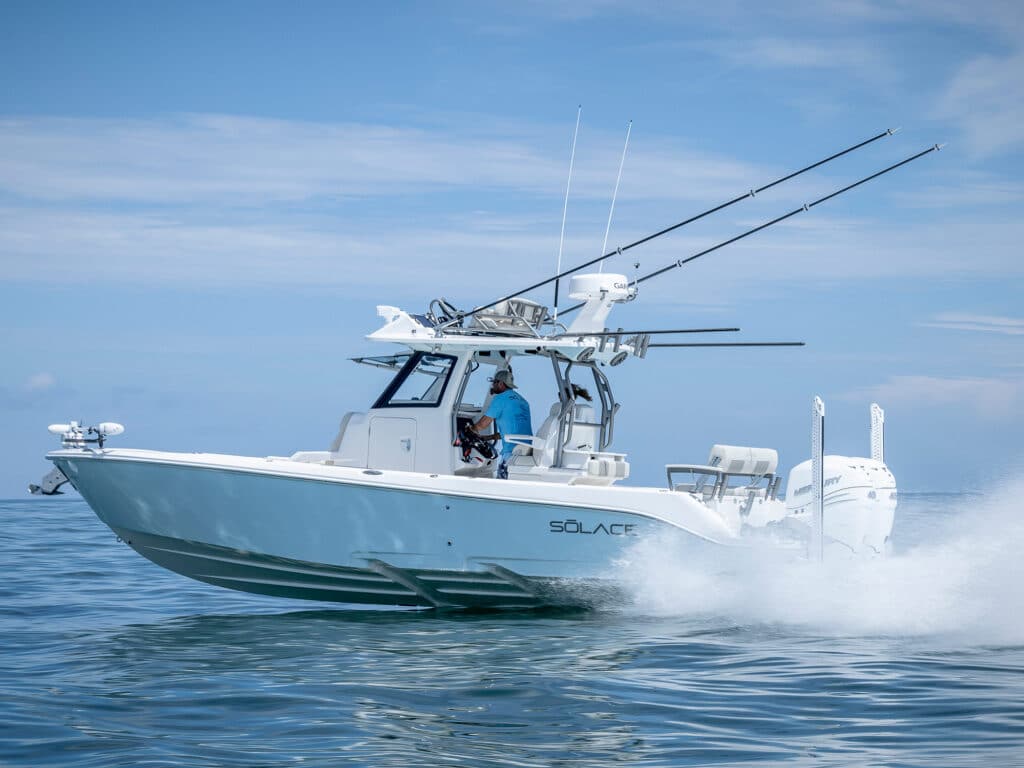
Solace Boats’ 30 HCS (Hybrid Center Step) is powered by twin Mercury Verado 400 V-10 outboards. The hull has a twin-step, variable-deadrise ventilated hull with a high-density PVC composite transom that offers 21 degrees of deadrise. Vacuum-infused carbon-fiber and epoxy laminate construction ensure strength and minimizes weight. The interior layout does away almost entirely with elevated casting platforms to maintain a consistent cockpit depth throughout. A pair of chairs sit atop the cover of the two 30-gallon transom livewells. The backrest of the cushioned seats pivot to let crewmembers face fore or aft. There are walk-throughs on both sides of the transom to access the swim platform, and you’ll find two 35-gallon in-deck fish boxes flanking the cockpit. The console features a seamless integrated three-sided glass windshield with electric rams to fully open the front panel, and a pair of deluxe helm seats cradle captain and co-pilot. The back of the leaning post has a rigging center with a sink, faucet and cutting boards, and a cooler underneath. The forward console has a lounge, and wraparound seating adorns the bow. Entrance to the console lies to port, and the interior provides more than 6 feet of headroom, a vanity with a Corian countertop, a stainless-steel sink, and an electric macerated freshwater toilet. An optional stand-through upper station is available.
- LOA: 29’10”
- Beam: 9’10”
- Weight: 10,000 lb. (with power)
- Fuel Capacity: 187 gal.
REGULATOR 30XO
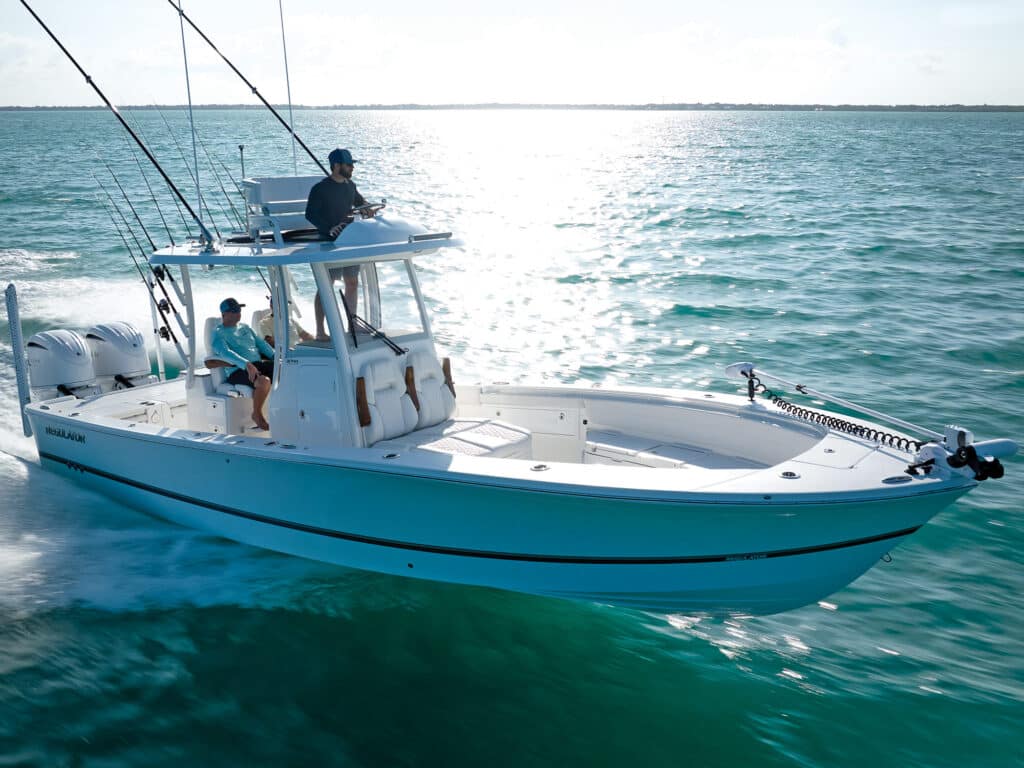
Regulator’s 30XO features include twin Yamaha F300 DES outboards, and Yamaha’s Helm Master EX joystick control is an available option. You can also order an optional half-tower station, and a convertible tackle and entertainment station. A forward casting platform with deep gunwales enhances safety. The aft casting platform offers jump seats that fold out from underneath. Anglers will love the combined 341 gallons of fish box, livewell and storage space, the 10 rocket launchers on the helm station, and optional under-gunwale locking rod storage. The 30XO offers plenty of seating, with the option to upgrade to diamond-quilted upholstery and add teak accents for a rich, classic look. The standard forward console settee delivers 218 quarts of cooler space, while the flush-folding rear cockpit seats house integrated dual bucket holders, an oversize bilge and a mechanical access center. The dash can accommodate two 16-inch Garmin 8616xsv multifunction displays. Regulator’s proprietary user interface called MyHelm offers easy-to-use functions on the touchscreen. The system even has its own key fob for controlling the Power-Poles, jack plate, spreader lights, light bar and deck lights. With 15 degrees of transom deadrise and a draft of 1 foot, 9 inches, the 30XO can ply inshore waters, but the hull also has the forward-V and heft to safely head offshore.
- Beam: 10”2”
- Draft: 1’9” (engines up)
- Transom Deadrise: 15 degrees
- Weight: 9,525 lb. (with power)
- Fuel Capacity: 222 gal.
- More: Boat Reviews , Center Consoles , fishing boats
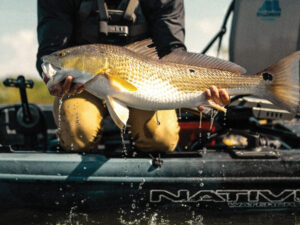
Best Kayaks for the Marsh


Small Boats for Offshore Fishing

What’s Good Fuel Economy for a Fishing Boat?

Yamaha Releases New 350 Horsepower Outboard
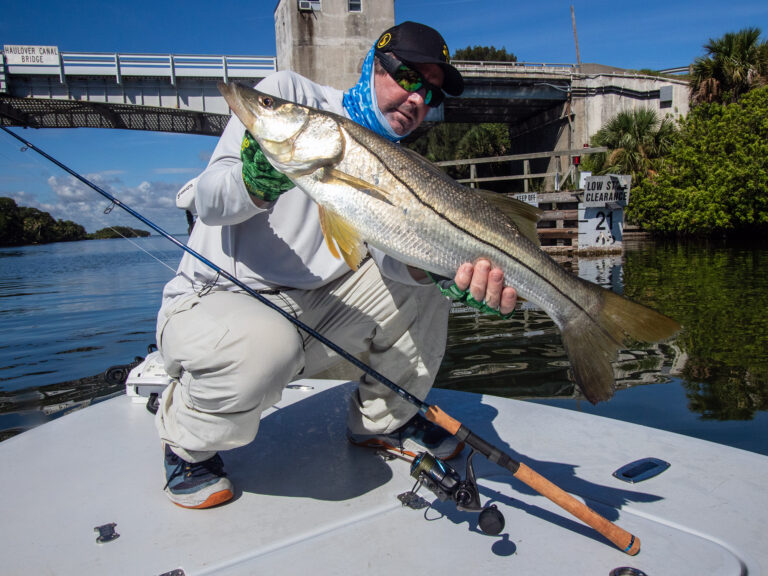
Make Mine a Jumbo

Sport Fishing’s Deals of the Week

Tracking Texas Tarpon

ODYSSEY Battery: Ask the Internet
- Privacy Policy
- Terms of Use
- Cruising World
- Sailing World
- Salt Water Sportsman
- Sport Fishing
- Wakeboarding
Many products featured on this site were editorially chosen. Sport Fishing may receive financial compensation for products purchased through this site.
Copyright © 2024 Sport Fishing Firecrown . All rights reserved. Reproduction in whole or in part without permission is prohibited.
Catamarans: A Complete Guide to Multihull Boats
Catamarans have been a part of sailing history for centuries and continue to be popular for their stability, spaciousness, and performance. Developed by various cultures around the world, the principles of catamaran design have evolved over time to become optimized for both pleasure cruising and racing. This complete guide will help you understand the essentials of catamarans, their unique characteristics, and how to choose the right one for your needs.

From the basic concepts of multihull design, performance, and handling, we will explore the advantages and benefits of a catamaran in terms of safety and comfort on board.
Along the way, we will discuss maintenance considerations, distinctive catamaran brands and models, and how a catamaran lifestyle can compare to more traditional sailing options .
Finally, we will provide learning resources and frequently asked questions tailored to both seasoned sailors and newcomers to the world of catamarans.
Key Takeaways
- Catamarans are known for their stability, spaciousness, and performance
- This guide covers aspects like design, handling, safety, and choosing the right catamaran
- Resources and frequently asked questions provide additional insights for potential catamaran owners
Understanding Catamarans
Design Characteristics
Catamarans are known for their unique design, which features two parallel hulls connected by a deck. This design provides several advantages over traditional monohull boats, such as stability and speed.
With their wide beam, catamarans have a reduced risk of capsizing and can access shallow waters due to their shallow drafts 1 .
One of the notable aspects of a catamaran is its twin hulls, which offer increased living space and comfort compared to a monohull. Additionally, catamarans are often favored by recreational and competitive sailors for their excellent maneuverability 2 .
The materials used for constructing catamarans range from wood to fiberglass, and even aluminum for high-performance vessels. Aluminum catamarans are known for their strength, lightweight structure, and resistance to corrosion 3 .
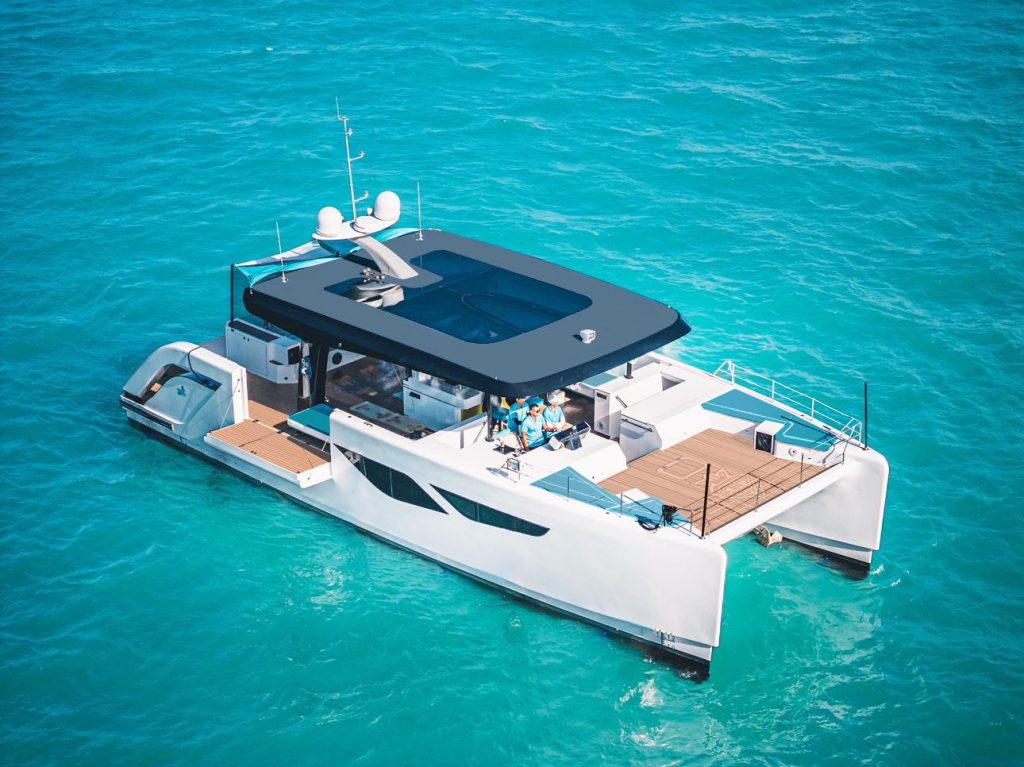
Hulls and Construction
The hulls in a catamaran are crucial to its stability and performance. These hulls help distribute the weight evenly across the water surface, minimizing drag and allowing for smoother sailing.
In general, the hulls can be categorized into two types:
- Symmetrical Hulls : The hull shape is similar on both sides, which enhances balance and stability in various sailing conditions.
- Asymmetrical Hulls : One side of the hull is designed differently than the other, which can be advantageous when sailing upwind.
The construction materials used in building catamaran hulls also play a vital role in the boat's performance and durability. Common materials include:
- Fiberglass : A popular choice due to its lightweight, strength, and ease of maintenance.
- Wood : Traditional material that offers a classic look, but requires more maintenance than fiberglass or aluminum.
- Aluminum : Lightweight and strong, aluminum is an excellent choice for high-performance catamarans 4 .
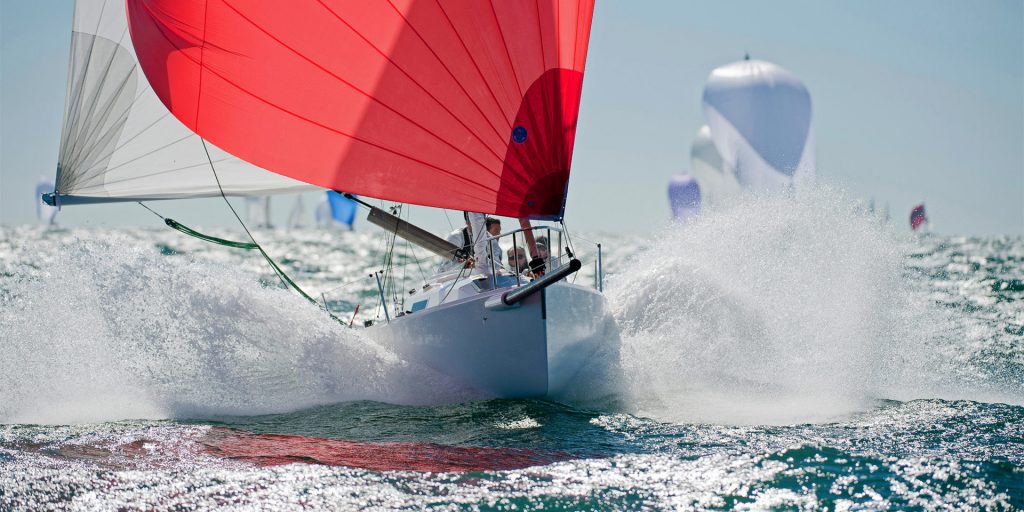
Multihulls vs Monohulls
There's often a debate between the benefits of multihull boats, such as catamarans or trimarans, and monohull boats. Here are some key differences between the two:
- Stability : Due to their wide beam and reduced heeling, catamarans offer improved stability compared to monohulls. This makes them an attractive option for those who want to avoid seasickness or feel more comfortable on the water 5 .
- Speed : Multihull boats are known for their speed, which results from their ability to minimize drag and maintain a level sail.
- Living Space : Catamarans and other multihulls generally have more living space, as both the hulls and the connecting deck can be utilized for accommodation and storage.
- Maneuverability : While monohulls are known for their agility and ability to point close to the wind, catamarans can still offer exceptional maneuverability when properly sailed 6 .
Performance and Handling
Speed and Efficiency
Power catamarans have gained popularity for offering a unique combination of speed, efficiency, and stability. Their dual-hull design allows for less water resistance, which directly translates to higher speeds and better fuel efficiency compared to traditional monohull boats.
In addition, the wide beam provided by the two hulls ensures a stable ride even at higher speeds. This makes power catamarans ideal for cruising, fishing, and watersports ( Boating Beast ).
Sailing Dynamics
When it comes to sailing catamarans , the performance is affected by factors such as keel, rudders, mast, and sails.
Their wide beam and dual-hull design provide inherent stability and reduced heeling effect, making them less likely to capsize compared to monohulls.
I should also note that catamarans have a shallow draft, which gives them the ability to access shallow waters that may be off-limits to other boats ( Navigating the Waters ).
In my experience, the lighter weight of a catamaran and its aerodynamic design can contribute to remarkable sailing performance under different wind conditions.
The larger sail area relative to hull weight allows them to harness more wind power, further enhancing their speed and agility on the water.
Maneuvering and Docking
Maneuvering and docking a power catamaran involves understanding its unique handling characteristics.
The presence of two engines in separate hulls allows for more precise control in confined spaces such as marinas.
The maneuverability of these boats is typically improved by the use of dual rudders that are located close to each powered hull for efficient steering ( BoatUS ).
When docking under power, I find it helpful to carefully assess the wind and current conditions beforehand.
This is because catamarans can be more sensitive to windage due to their larger surface area above the waterline.
By understanding how these forces may affect the boat, I can make adjustments to my approach and successfully dock the catamaran without any incidents.
Safety and Comfort on Board
Safety Features
Safety is a top priority when sailing any type of vessel, including catamarans. A well-built catamaran offers several features aimed at ensuring the safety of those onboard.
First, catamarans have inherent stability due to their wide beam and twin hull design . This makes them less prone to capsizing than monohull boats. This stability allows me to confidently navigate various water conditions .
In addition to stability, catamarans are designed with positive buoyancy, making them almost unsinkable . Of course, safety equipment such as lifejackets, flares, and first aid kits should always be onboard and well-maintained.
Furthermore, you should also stay updated on weather conditions, avoid sailing in high-risk areas, and learn your boat's safe sail limits.
Living Spaces and Comfort
When it comes to living spaces, I value comfort and practicality as essential features for my time on the water. Catamarans offer a unique advantage in this regard, as their dual hulls create spacious living areas.
Most catamarans are designed with separate cabins in each hull, allowing for privacy and comfort when sleeping. Additionally, these boats typically feature shallow drafts , which means I can access shallow waters and anchor close to shore.
The main living area, or salon, is situated on the bridge deck between the hulls. It usually includes a seating area, a dining table, and a galley (kitchen). Large windows provide ample natural light and panoramic views, making the space feel open and bright. Some catamarans even have the option for an additional living area on the upper deck where you can enjoy the sun and breeze.
One aspect of catamaran living I truly appreciate is the ample storage available. Each cabin typically has built-in storage spaces for clothes, gear, and personal items. There are also designated areas for equipment such as spare sails, tools, and water toys. This makes it easy for me to keep my belongings organized and make the most of my time on the water.
Maintaining a Catamaran
Routine Maintenance
In order to keep my catamaran in the best possible shape, I make sure to perform routine maintenance tasks. These tasks are essential to extend the life of the components and ensure smooth sailing:
- Cleaning : Regularly cleaning the deck, hulls, and sails prevents buildup of dirt, algae, and other debris that could affect performance.
- Inspection : Periodically inspecting my catamaran allows me to detect any potential issues before they become significant problems. I pay close attention to the rigging, sails, and lines on my boat.
- Lubrication : Keeping all moving parts lubricated is vital to prevent friction and wear on components such as winches and pulleys.
- Antifouling : Applying antifouling paint to the hulls of my catamaran helps prevent the growth of marine organisms that can damage the boat and reduce its speed. Make sure to do this at least once a year.
Dealing with Wear and Tear
Despite my best efforts to keep my catamaran well-maintained, wear and tear is inevitable. Here's how I deal with common issues that could arise from regular use:
- Repairs : When I notice signs of wear on sails, lines, or rigging components, I make it a priority to repair or replace them promptly. Neglecting these issues can lead to more significant problems and affect the boat's performance.
- Hull maintenance : If I find dents, scratches, or stiff rudders on my catamaran's hulls, I address them immediately. Repairing any damage not only ensures smooth sailing but also prevents further issues from developing.
- Sail care : Over time, my sails can become stretched, torn, or damaged due to exposure to sun, wind, and saltwater. Regularly inspecting them for signs of wear and making any necessary repairs or replacements helps maintain optimal performance.
- Rust and corrosion prevention : Since my catamaran is made of various metal components, I need to protect them from rust and corrosion. I routinely check for signs of corrosion and apply anti-corrosive treatments when needed.
Catamaran Brands and Models
High-Performance Models
In recent years, there has been a growing interest in high-performance catamarans. I have seen a variety of brands and models that have impressed me with their performance capabilities. One notable brand is Fountaine Pajot , which has a long history of producing a range of sailing catamarans and power catamarans. Some of their popular models include the Tanna 47 and the Bali 4.4 .
Another high-performance catamaran I've come across is the Leopard 40 . Known for their speed and exceptional handling in various conditions, the Leopard brand started with sailing catamarans and has since expanded to include power catamarans. Their models range from 40 to 53 feet long, offering both power and luxury for those looking for a thrilling experience on the water.
Cruising Catamarans
When it comes to cruising catamarans, the Lagoon brand is synonymous with luxury and comfort. With a range of sailing catamarans from 40 to 70 feet long, Lagoon offers spacious catamarans for extended bluewater cruising. Their 60- and 70-foot power catamarans are equally impressive, providing ample living space and smooth sailing experiences.
I've also found the Aquila 42 PC to be a remarkable cruising catamaran. With a focus on design and innovation, Aquila has produced catamarans perfect for exploring the open sea with friends and family. Their spacious, stable designs allow for a more enjoyable and serene journey, ensuring you arrive at your destination comfortably.
The Catamaran Lifestyle
Anchoring and Cruising
I find catamarans to be a fantastic choice for cruising and anchoring , which is a critical part of living the catamaran lifestyle . Catamarans have several advantages when it comes to anchoring and cruising, such as:
- Stability : Due to their wide beam and twin hulls, catamarans remain stable during anchoring, which reduces the risk of seasickness.
- Shallow draft : Thanks to their shallow draft , catamarans can anchor close to shore, enabling better access to protected coves and more beautiful beaches.
- Speed : Despite their large size for cruising vessels , catamarans are generally faster than monohulls. This is a result of their slim hulls and reduced water resistance.
When it comes to anchoring, catamarans can make use of their shallow draft to anchor in locations that other boats cannot. This allows for a greater range of cruising spots, which makes the overall experience much more enjoyable and unique.
Living on a Catamaran Full-time
For many catamaran enthusiasts, the dream of living full-time on a catamaran is entirely possible. While not without challenges, there are several factors that make living aboard a catamaran an enjoyable experience:
- Spacious living areas : Catamarans generally have more living area compared to monohulls, providing ample space for the whole crew.
- Privacy : The separate hulls allow for private cabins, ensuring that everyone on board has their space.
- Stability : As mentioned earlier, catamarans are stable vessels, making living on them more comfortable than monohulls.
Choosing Your Catamaran
Comparing Models and Features
When I start to look for the perfect catamaran, the first thing I focus on is comparing various models and features .
I determine the key factors that are essential for my needs, such as size, passenger comfort, and performance. By doing so, I can identify which catamaran models are most suitable for me.
For example, if I plan to sail with a large group, I would look for a catamaran that offers ample space both inside and out.
To help me with my comparisons, I usually create a table or list of the different models and their features:
| Model | Size | Comfort | Performance |
|---|---|---|---|
| A | 40ft | Spacious | High |
| B | 35ft | Average | Average |
| C | 45ft | Luxury | High |
This visual aid makes it easier for me to sort the options and prioritize my considerations, such as price, yacht type, and brand.
New vs. Second-Hand
Another critical aspect of choosing a catamaran is deciding between a new or second-hand boat.
Both options have their pros and cons, and ultimately it depends on my preferences and budget.
If I can afford a new catamaran, I get the advantage of the latest design , features, and technology. Plus, I typically receive better warranty coverage and support from the manufacturer.
However, new catamarans are more expensive and can have long wait times due to high demand.
On the other hand, purchasing a second-hand catamaran can save me a significant amount of money, and I might find a high-quality boat with low mileage or well-maintained by the previous owner.
However, this option carries more risks, as I need to be knowledgeable about potential maintenance issues and conduct a thorough inspection before purchase.
Learning Resources
Books and Manuals
When it comes to learning about catamarans, there are plenty of books and manuals available.
One of the highly recommended books is Multihull Voyaging by Thomas Firth Jones. This book provides a comprehensive understanding of multihulls, including catamarans, and is an essential guide for any beginner sailor.
Another great book to check out is Catamarans: The Complete Guide for Cruising Sailors by Gregor Tarjan.
With a foreword by Charles K. Chiodi, publisher of Multihulls Magazine, this book covers all aspects of cruising catamarans. It includes detailed information on design, construction, and maintenance, as well as tips and tricks for sailing a catamaran.
Here are a few more books that I find valuable:
- The Catamaran Book by Tim Bartlett, an excellent resource for both beginners and experienced sailors
- Catamaran Sailing: From Start to Finish by Phil Berman and Lenny Rudow, a comprehensive guide to both catamaran racing and cruising
Online Content and Photography
In addition to books, you can find plenty of online content and photography about catamarans.
Websites like Sailaway Blog and Boating Guide offer tips, techniques, and how-to articles for sailing catamarans.
Many of these sites also include stunning photography, showcasing these beautiful vessels in action.
For those who prefer Kindle or e-books, many of these resources are available in digital format.
This makes it easier for you to access them anytime, anywhere, allowing you to keep learning and improving your catamaran sailing skills.
To further enhance your knowledge, you can also join online forums and communities dedicated to catamarans.
These platforms provide invaluable advice and first-hand experiences shared by fellow sailors, as well as recommendations for additional learning resources.
Frequently Asked Questions
What factors should be considered when choosing a catamaran for full-time living?
When choosing a catamaran for full-time living, consider its space and layout , as it will become your home.
Look for a design with a comfortable living area , ample storage, and sufficient berths for the number of people living aboard.
Also, consider fuel efficiency , ease of maintenance, and the catamaran's cruising range .
Lastly, the overall cost of ownership , including insurance and mooring fees, should be considered.
How do catamarans perform in rough sea conditions?
In general, catamarans are known for their stability, which is primarily due to their wide beams. This makes them less prone to capsizing when compared to monohulls.
However, their performance in rough sea conditions will depend on the specific model and design of the catamaran. Some may perform better in certain conditions than others, so researching and selecting the right design is essential.
What are the key differences between sailing a catamaran and a monohull?
One of the main differences between catamarans and monohulls is stability.
Catamarans have a wider beam , which makes them more stable and minimizes the risk of capsizing.
They also have shallower drafts, which allow them to access more shallow waters compared to monohulls.
Additionally, catamarans often have larger living spaces, making them more comfortable and suitable for cruising and full-time living.
What are the advantages of catamarans for long-distance cruising?
Catamarans offer several advantages for long-distance cruising.
Their wide, stable design provides a comfortable ride and reduces the risk of seasickness.
They can also attain higher speeds due to their reduced drag and generally sail faster than monohulls on certain points of sail.
The shallow draft allows them to explore more coastal areas and anchor closer to shore. Lastly, their spacious interiors make them ideal for extended cruises and living aboard.
How does one assess the value of a used catamaran on the market?
Assessing the value of a used catamaran requires thorough research and inspection.
Start by comparing the age, model, and condition of the catamaran to similar listings on the market.
Take note of any upgrades or additions made to the boat, as these can affect the price.
It's essential to inspect the boat in person or hire a professional surveyor to ensure there are no hidden issues that could affect its value.
What essential features should be looked for in a catamaran intended for ocean voyages?
For ocean voyages, look for a catamaran with a strong, well-built hull designed to handle rough conditions.
Safety features such as liferafts, adequate flotation, and sturdy deck hardware are crucial.
A reliable engine and well-maintained rigging and sails are also essential.
In terms of living space, opt for a catamaran with a comfortable, spacious interior and ample storage.
Last but not least, good navigation and communication systems are necessary for long-distance ocean voyages.
Related Articles
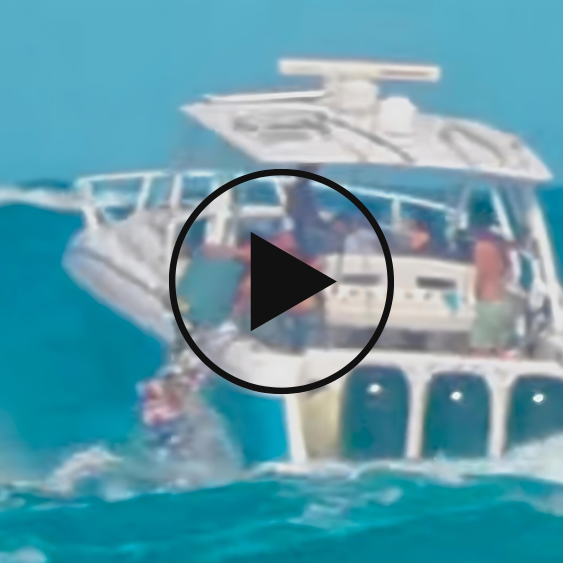
Chris and Lisa Ruth: Ocean Littering Scandal Post Boca Bash 2024

Manatee Conservation Efforts: Protecting Endangered Gentle Giants
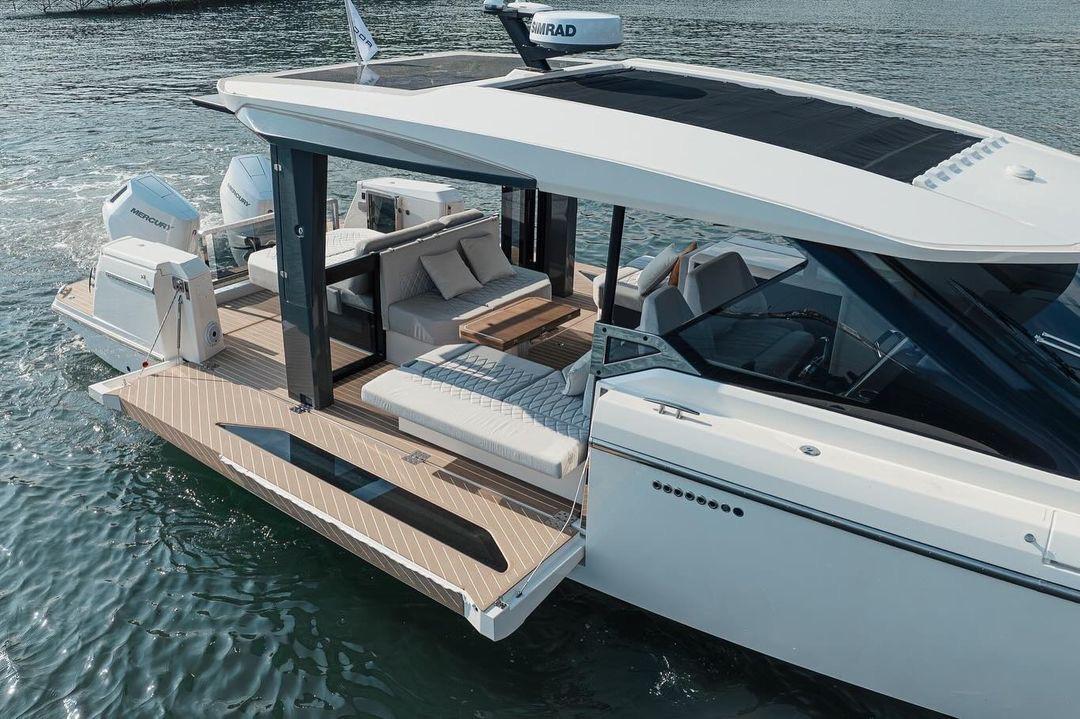
Saxdor 400 GTC- Price Breakdown: Unveiling True Value and Features
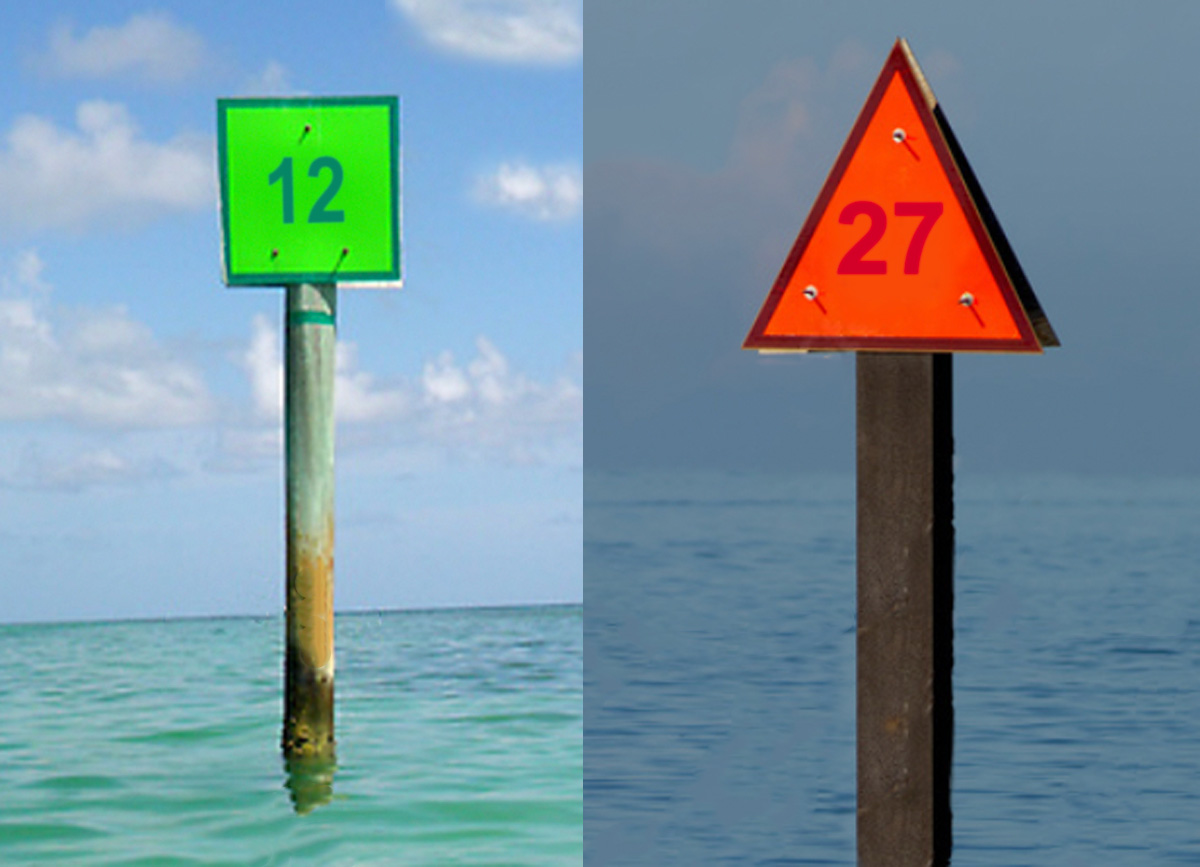
When Returning from Open Sea: Red Buoy Response Guide

2024 Best Outboard Engine Mods: Top Upgrades for Performance and Efficiency
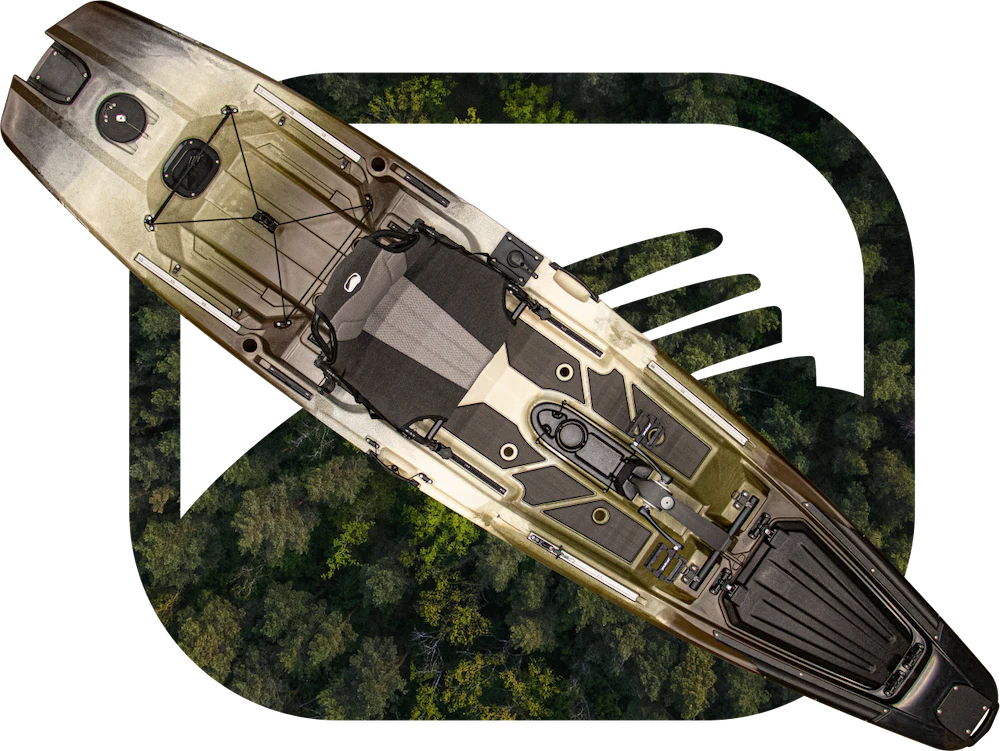
Bonafide Kayak: Unrivaled Stability and Performance on the Water
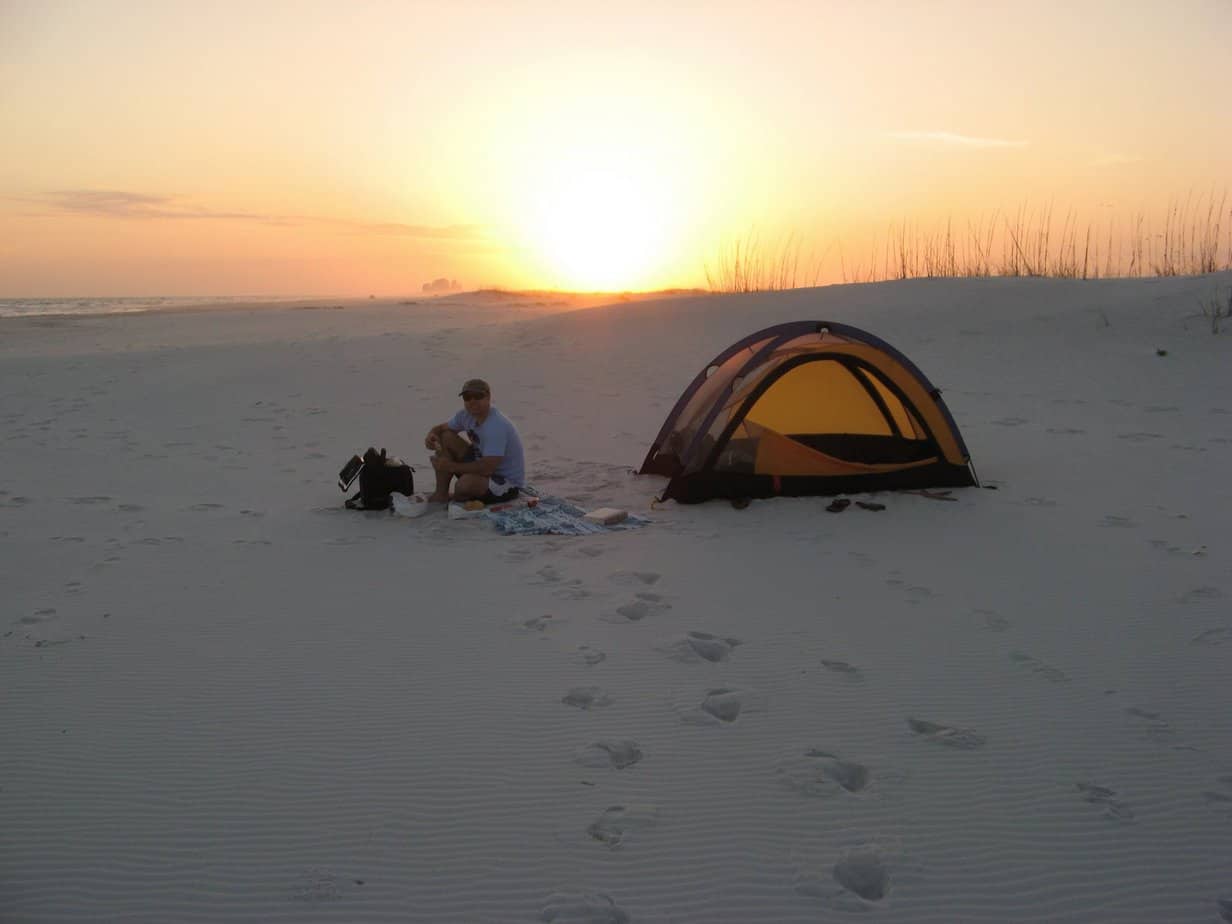
Beach Camping Florida: Your Guide to Sunshine State Shorelines
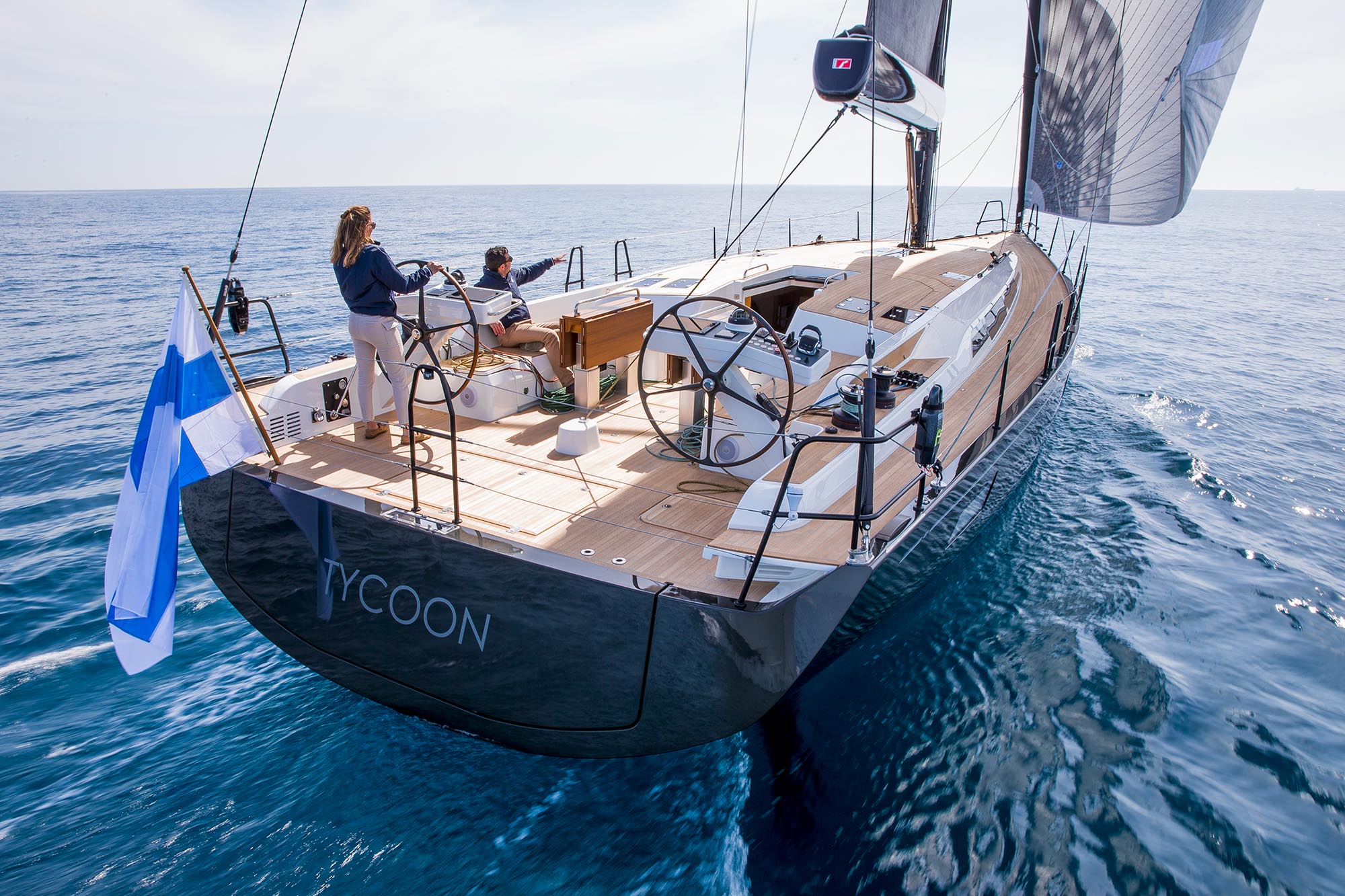
Types of Sailboats: Essential Guide for Every Sailor

- Build Your Boat
- Tideline 235 Hybrid
- Tideline 365 Offshore
- News & Events

- Schedule a Sea Trial
A Guide to Catamarans: Exploring the Beauty of Twin-Hull Vessels
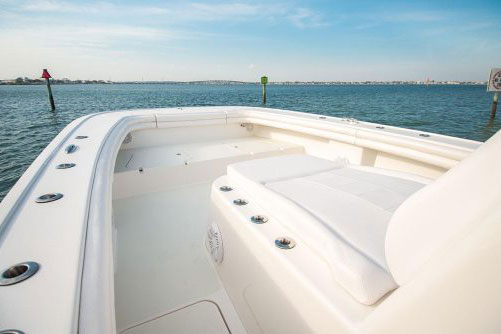
Catamarans are a fascinating class of vessels that have captured the imagination of sailors and water enthusiasts worldwide. With their distinctive twin-hull design and numerous advantages, catamarans have become increasingly popular in recent years. Whether you’re a seasoned sailor or a novice to the world of boating, this guide will introduce you to the allure of catamarans and help you navigate your way through these remarkable vessels.
Understanding Catamarans: The Basics
1. Twin-Hull Design : At the heart of every catamaran is its twin-hull design. Two parallel hulls provide stability and buoyancy. This design offers several advantages, including reduced rolling motion, increased deck space, and shallower draft, making them suitable for various water environments.
2. Stability : Catamarans are renowned for their exceptional stability. The wide-set hulls offer a solid platform, reducing the tendency to heel (tilt) in strong winds or rough seas. This stability is a key reason catamarans are favored by those who are prone to seasickness.
3. Speed and Fuel Efficiency : The dual-hull design creates less drag, allowing catamarans to achieve impressive speeds and superior fuel economy. The reduced water displacement means they can be faster and more fuel efficient than monohull vessels of the same size. This speed and fuel efficiency makes catamarans ideal for both leisure cruising and competitive racing.
4. Deck Space : Catamarans provide ample deck space, which is perfect for fishing, sunbathing, or just relaxing. The absence of a central keel and a tapered bow enables you to make the most of the deck space, often with a seamless connection between indoor and outdoor areas.
Types of Catamarans
Catamarans come in various shapes and sizes, each designed for specific purposes. Here are some common types:
1. Sailing Catamarans : These are designed primarily for sailing, offering the joy of wind-powered navigation. Sailing catamarans often have spacious living areas and are great for extended cruising.
2. Power Catamarans : Power catamarans are equipped with engines for those who prefer motor-driven propulsion. They are known for their efficiency, stability, and relatively shallow draft, making them suitable for a variety of applications, from fishing to luxury charters.
3. Cruising Catamarans : These are designed for long journeys, often with comfortable living quarters, kitchens, and spacious cabins. Cruising catamarans are popular for people looking to explore coastal and offshore destinations.
4. Racing Catamarans : These are built for speed and competitive racing. They have sleek designs, lightweight construction, and advanced rigging systems, making them the choice for adrenaline enthusiasts.
Advantages of Catamarans
1. Stability : Catamarans offer excellent stability both at anchor and underway. This stability is a key reason families and novice sailors often opt for catamarans.
2. Spacious Interiors : Catamarans provide ample living space, with multiple cabins, saloons, and kitchens. The wide beam allows for a comfortable and roomy interior.
3. Reduced Draft : Catamarans have a shallow draft, allowing them to access shallower waters, hidden coves, and secluded anchorages that might be off-limits to deeper-draft monohull boats.
4. Maneuverability : Catamarans can execute tight turns with precision, making them easier to dock and navigate in marinas.
5. Safety : Thanks to their buoyancy and stability, catamarans are less prone to capsizing, making them a safer choice, especially for families.
Challenges of Catamarans
1. Maintenance : Catamarans often have more complex systems due to their twin engines and two hulls, which can result in increased maintenance requirements.
2. Cost : Catamarans are generally more expensive than monohull boats of similar size and age.
3. Docking Space : The wider beam of catamarans can require wider slips in marinas, which may limit docking options in some locations.
Sailing the Seas in Style
Catamarans offer a unique and exciting way to explore the world’s oceans, rivers, and lakes. Their stability, speed, and spaciousness make them an excellent choice for a wide range of water-based activities, from leisurely cruising to competitive racing. Whether you’re looking for a family-friendly vessel, a luxurious yacht, or a thrilling racing machine, catamarans have something to offer every sailor and water enthusiast. So, if you’re ready to set sail in style and comfort, consider exploring the world of catamarans and discovering the beauty of twin-hull vessels.
As you embark on your journey of discovering the world of catamarans, remember that Tideline Fishing Catamarans stands out as a shining example of excellence in this industry. With their dedication to crafting high-performance, quality vessels that seamlessly blend classic aesthetics with modern innovation, Tideline has redefined the fishing experience for anglers worldwide. If you’re intrigued by the idea of a fishing catamaran that offers exceptional comfort and seaworthiness, check out our website to explore a range of customizable models. The horizon awaits, and with Tideline Boats, your adventure is bound to be unforgettable.
- Catamarans: Exploring the beauty of twin-hulled boats
Catamarans, with their unique twin-hull design, have gained popularity among boating enthusiasts worldwide. Offering stability, speed, and ample space, catamarans have become a favored choice for sailing, cruising, and even fishing. In this article, we'll delve into the world of catamarans, exploring their features, advantages, and various uses. Whether you're a seasoned sailor or considering purchasing your first boat, join us as we set sail to discover the beauty of catamarans.
Advantages of catamarans
A catamaran is a type of boat characterized by two parallel hulls connected by a deck. This design offers increased stability and reduced drag, allowing for smooth sailing and enhanced performance.
Catamarans offer several advantages over traditional monohull boats. These include:
- Stability: The twin-hull design provides excellent stability, minimizing rocking and rolling even in rough waters.
- Speed: With reduced drag and lighter weight, catamarans are known for their impressive speed and efficiency.
- Spaciousness: The wide beam of a catamaran allows for more interior space, providing comfortable living areas, cabins, and deck space.
- Shallow Draft: Catamarans typically have a shallow draft, making them suitable for cruising in shallow waters and exploring coastlines and coves that are inaccessible to deeper-draft boats.
- Enhanced Safety: The twin-hull configuration offers redundancy and increased buoyancy, making catamarans less prone to capsizing.
Sailing catamarans
Sailing catamarans have gained popularity among sailing enthusiasts for their excellent performance and comfort. With their wide beam and efficient sail plans, they can achieve impressive speeds and provide a stable and enjoyable sailing experience.
Catamaran design and construction
Catamarans are constructed using various materials such as fiberglass, aluminum, or composite materials. They can be custom-built or manufactured by renowned boat builders who specialize in catamaran construction.
Read our top notch articles on topics such as sailing, sailing tips and destinations in our Magazine.
Catamaran sses and activities
Catamarans are versatile and can be used for a variety of activities. Some common uses include:
Cruising and liveaboard
Catamarans are well-suited for extended cruising and liveaboard lifestyles, offering spacious accommodations and the ability to carry ample supplies and provisions.
Chartering and tourism
Due to their size and comfort, catamarans are popular for chartering and tourism purposes, providing vacationers with luxurious and memorable experiences on the water.
Catamarans are known for their competitive edge in sailing races. Their speed, stability, and maneuverability make them a favored choice among racing enthusiasts.
Catamarans designed specifically for fishing offer stability, deck space, and specialized equipment, making them ideal for anglers seeking a productive and enjoyable fishing experience.
Small catamarans for recreation
For those looking for smaller recreational options, there are compact catamarans available that are perfect for day sailing, coastal exploring, or simply enjoying leisurely time on the water.
Buying a catamaran: Factors to consider
When purchasing a catamaran, factors such as size, budget, intended use, and maintenance requirements should be taken into account. Conduct thorough research, consider professional advice, and take your time to find the perfect catamaran for your needs.
Catamaran maintenance and care
Proper maintenance is crucial for keeping your catamaran in top condition. Regular cleaning, hull inspections, and routine mechanical checks are essential to ensure the longevity and performance of your boat.
Catamarans offer a unique and captivating boating experience. With their stability, speed, spaciousness, and versatility, they have become a popular choice for sailing enthusiasts, cruisers, and fishermen alike. Whether you're seeking an exciting adventure, a luxurious vacation, or a peaceful coastal exploration, a catamaran can provide the perfect platform to elevate your boating experience.
So what are you waiting for? Take a look at our range of charter boats and head to some of our favourite sailing destinations .
FAQs about catamarans

IMAGES
VIDEO
COMMENTS
Here is the answer for the crossword clue Twin-hulled sailboat . We have found 40 possible answers for this clue in our database. Among them, one solution stands out with a 98% match which has a length of 9 letters. We think the likely answer to this clue is CATAMARAN. Crossword Answer For Twin-hulled sailboat:
The Crossword Solver found 30 answers to "Twin hulled sailboat", 9 letters crossword clue. The Crossword Solver finds answers to classic crosswords and cryptic crossword puzzles. Enter the length or pattern for better results. Click the answer to find similar crossword clues. Enter a Crossword Clue. A clue is required.
Here is the answer for the crossword clue Twin-hulled boat last seen in Commuter puzzle. We have found 40 possible answers for this clue in our database. Among them, one solution stands out with a 98 % match which has a length of 9 letters. We think the likely answer to this clue is CATAMARAN.
A catamaran is a twin-hull boat with two equally-sized hulls placed side by side. They're powered by engines, sails, or both—and they're known for efficiency and speed. Catamarans are the most common kind of multihull boat. In this article, we'll go over the characteristics of catamarans and how to differentiate them from other types of ...
These sailboats have a minimum total sail area of 624 square feet, a maximum total sail area of 3,630 square feet and an average of 968 square feet. Boat Trader currently has 199 multi-hull sailboats for sale, including 76 new vessels and 123 used and custom yachts listed by both individual owners and professional boat dealers mainly in United ...
Twin-hulled boat is a crossword puzzle clue that we have spotted 10 times. There are related clues (shown below). There are related clues (shown below). Referring crossword puzzle answers
It is a type of multi-hulled boat, with two parallel hulls of equal size, also known as pontoon boats. This unique double-hulled design originated from traditional fishing boats and sailing vessels in the South Pacific and offers a range of benefits for sailors. They are available in various sizes and can be powered by sails or engines, making ...
Twin-hulled sailboat is a crossword puzzle clue that we have spotted 3 times. There are related clues (shown below). There are related clues (shown below). Referring crossword puzzle answers
Other crossword clues with similar answers to 'Twin-hulled boat'. A cart man manoeuvres around a boat. Animal primarily ate mice and rats aboard new vessel. Boat made by Russian woman in prison. Boat of Spaniard left to go to ruin.
There are a wide range of Multi-Hull boats for sale from popular brands like Fountaine Pajot, Lagoon and Corsair with 305 new and 1,093 used and an average price of $537,145 with boats ranging from as little as $25,354 and $3,795,483. View a wide selection of multi-hull boats for sale in your area, explore detailed information & find your next ...
The Caymas 281 HB hybrid bay boat is available with twin Mercury, Suzuki and Yamaha outboards up to 600 hp total. A 200-gallon fuel capacity results in superb cruising range. A Michael Peters double SVVT (Stepped-Vee Ventilated Tunnel) hull delivers speed, a smooth ride, and fuel efficiency.
A Formula 16 beachable catamaran Powered catamaran passenger ferry at Salem, Massachusetts, United States. A catamaran (/ ˌ k æ t ə m ə ˈ r æ n /) (informally, a "cat") is a watercraft with two parallel hulls of equal size. The distance between a catamaran's hulls imparts resistance to rolling and overturning. Catamarans typically have less hull volume, smaller displacement, and ...
A well-built catamaran offers several features aimed at ensuring the safety of those onboard. First, catamarans have inherent stability due to their wide beam and twin hull design. This makes them less prone to capsizing than monohull boats. This stability allows me to confidently navigate various water conditions.
A twin-hull boat is composed of two separate hulls that are connected by a deck. This design has been around since the early 1900s and is still one of the most popular types of boats today. It offers good stability, low drag, and good carrying capacity. However, twin hulls can be more difficult to maneuver, and they require more energy to move ...
Multihull. The relationship between monohulls & multihulls. A multihull is a boat or ship with more than one hull, whereas a vessel with a single hull is a monohull. The most common multihulls are catamarans (with two hulls), and trimarans (with three hulls). There are other types, with four or more hulls, but such examples are very rare and ...
And a look at the 23CC will prove it. Though the name Carolina Cat may not yet be familiar, don't worry - the builders have plenty of experience with twin-hulled power catamarans. First, simply consider the size of this boat, the power it requires, and the performance it gets. At 22'7" long and 8'6" wide, you can enjoy expansive deck ...
Understanding Catamarans: The Basics. 1. Twin-Hull Design: At the heart of every catamaran is its twin-hull design. Two parallel hulls provide stability and buoyancy. This design offers several advantages, including reduced rolling motion, increased deck space, and shallower draft, making them suitable for various water environments. 2.
These boats are built by a wide variety of boat building companies with hull types including catamaran, deep vee, pontoon, semi-displacement and other designs. Boat Trader currently has 723 power catamaran boats for sale, including 326 new vessels and 397 used boats, listed by both individuals and professional dealers across the country.
Stability: The twin-hull design provides excellent stability, minimizing rocking and rolling even in rough waters. Speed: With reduced drag and lighter weight, catamarans are known for their impressive speed and efficiency. Spaciousness: The wide beam of a catamaran allows for more interior space, providing comfortable living areas, cabins, and ...
These twin-hull boats offer many advantages over monohulls, though they offer some disadvantages as well. The cat-versus-mono debate has been driven into the ground through years of discourse, but whichever hull design you favor the basic argument can be boiled down to this: Powercats usually display superior efficiency and stability, a softer ...
Of the boats listed, Twin Vee offers familiar boat hull types and designs including catamaran and deep vee. These vessels are frequently used for conventional boating activities such as day cruising, saltwater fishing, freshwater fishing, overnight cruising and watersports. The boats available here currently from this builder come with outboard ...
catamaran, twin-hulled sailing and powered boat developed for sport and recreation in the second half of the 20th century. Its design is based on a raft of two logs bridged by planks that had earlier been used by peoples in the Indonesian archipelago and throughout Polynesia and Micronesia. Early catamarans were up to 21.3 metres (70 feet) long, originally paddled by many men, and used for ...